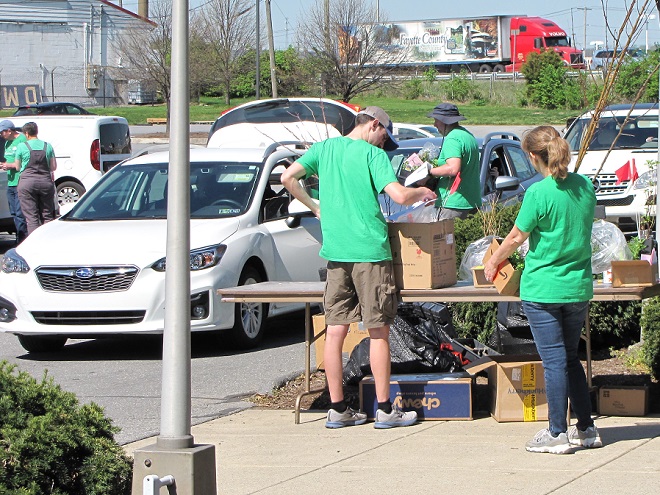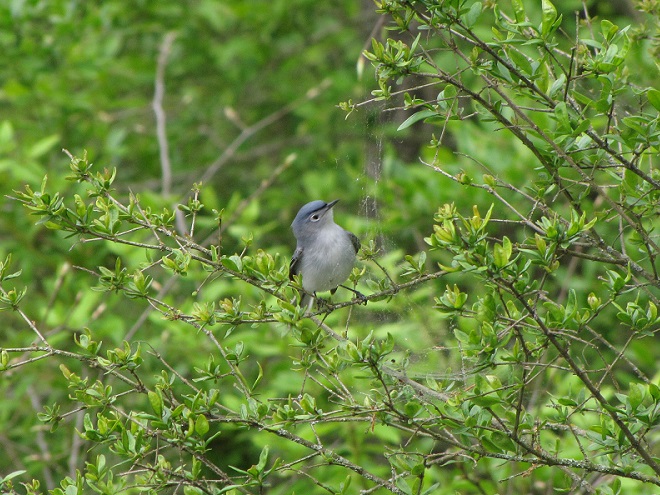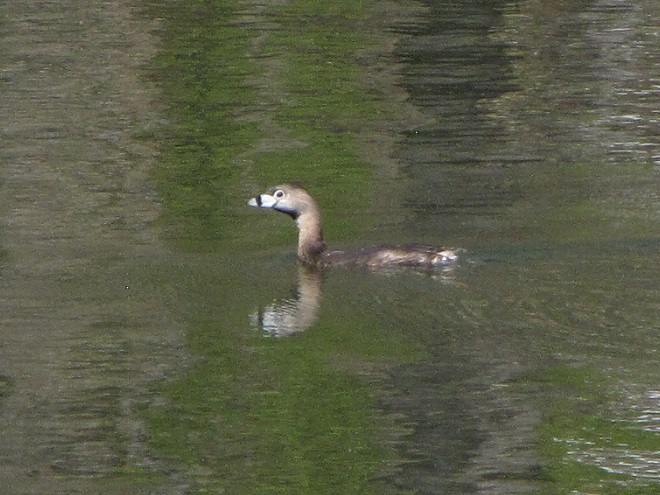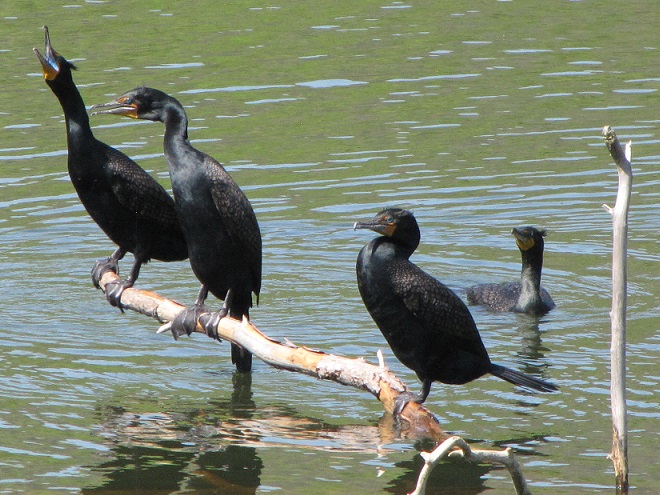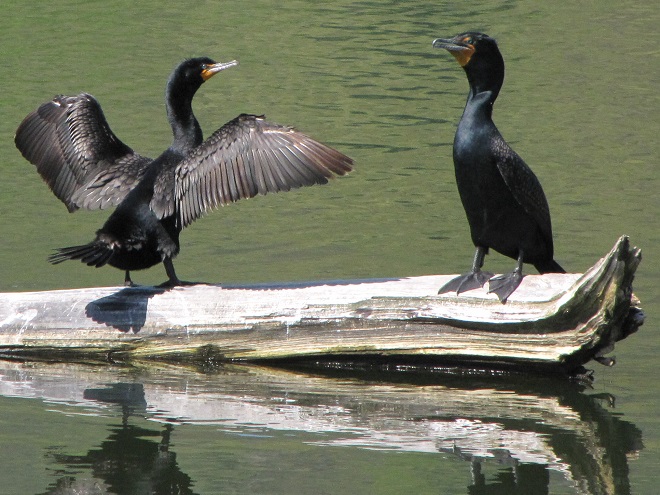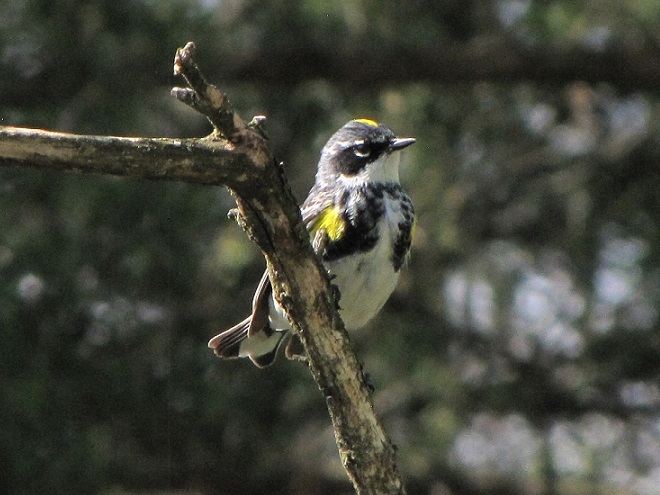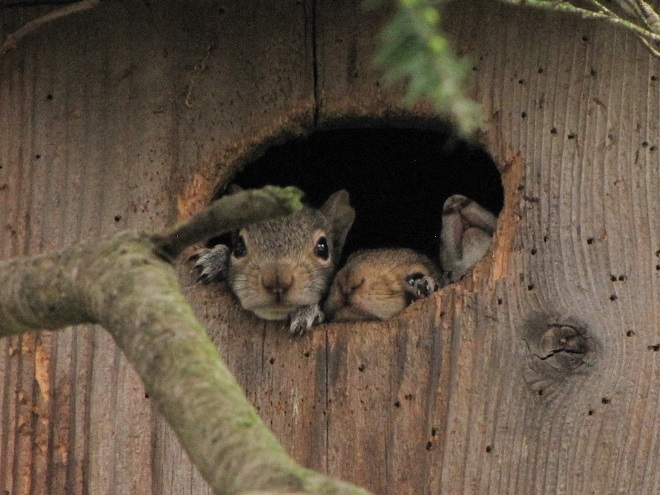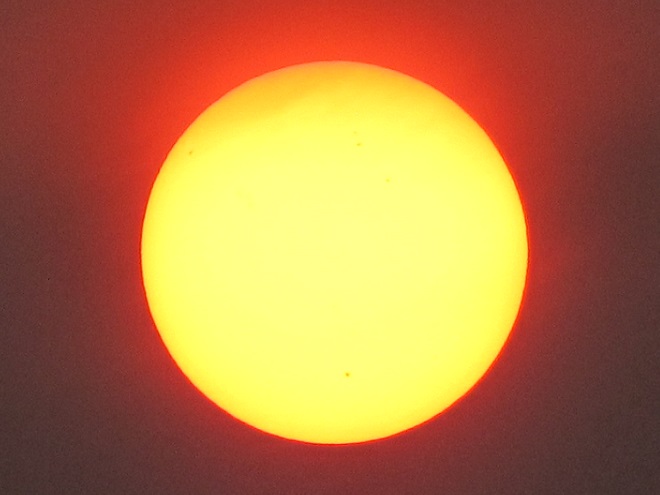
The Smoke is About to Get Even Thicker
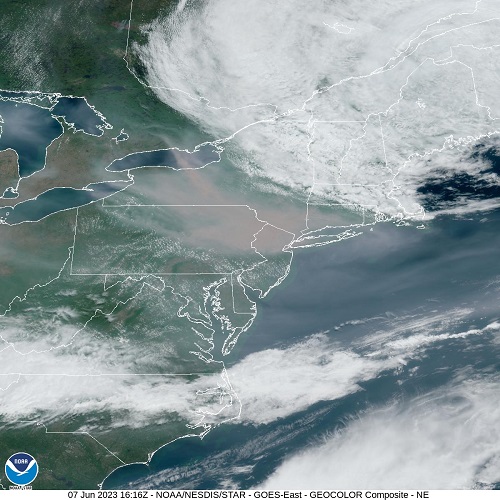
Watch the cloud on the move—click here for a GIF animation of this image.
The Value of Water
Are you worried about your well running dry this summer? Are you wondering if your public water supply is going to implement use restrictions in coming months? If we do suddenly enter a wet spell again, are you concerned about losing valuable rainfall to flooding? A sensible person should be curious about these issues, but here in the Lower Susquehanna River Watershed, we tend to take for granted the water we use on a daily basis.
This Wednesday, June 7, you can learn more about the numerous measures we can take, both individually and as a community, to recharge our aquifers while at the same time improving water quality and wildlife habitat in and around our streams and rivers. From 5:30 to 8:00 P.M., the Chiques Creek Watershed Alliance will be hosting its annual Watershed Expo at the Manheim Farm Show grounds adjacent to the Manheim Central High School in Lancaster County. According to the organization’s web page, more than twenty organizations will be there with displays featuring conservation, aquatic wildlife, stream restoration, Honey Bees, and much more. There will be games and custom-made fish-print t-shirts for the youngsters, plus music to relax by for those a little older. Look for rain barrel painting and a rain barrel giveaway. And you’ll like this—admission and ice cream are free. Vendors including food trucks will be onsite preparing fare for sale.
And there’s much more.
To help recharge groundwater supplies, you can learn how to infiltrate stormwater from your downspouts, parking area, or driveway…
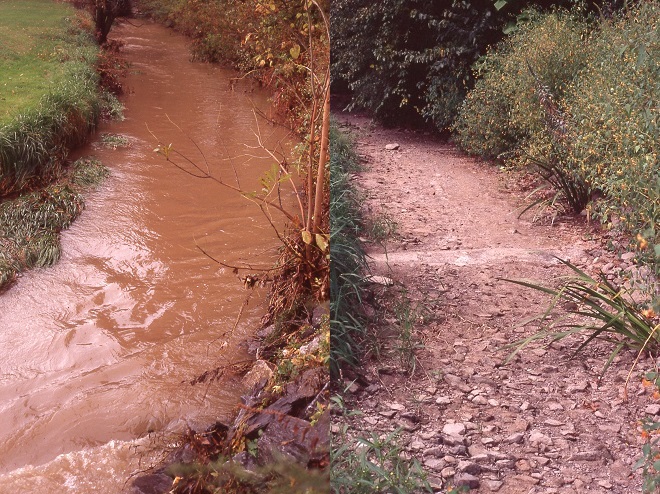
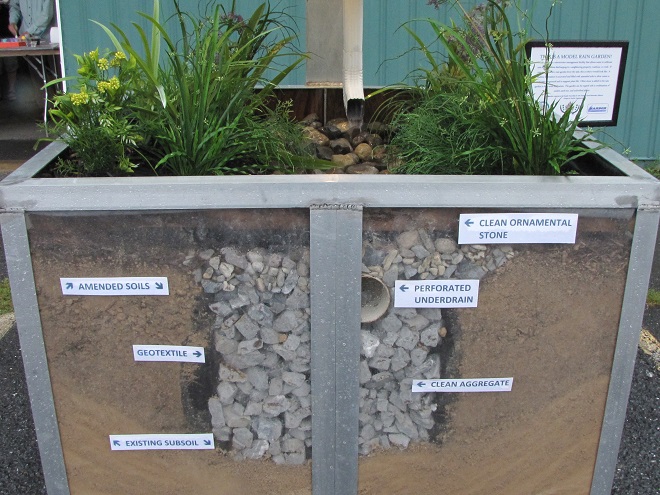
…there will be a tour of a comprehensive stream and floodplain rehabilitation project in Manheim Memorial Park adjacent to the fair grounds…

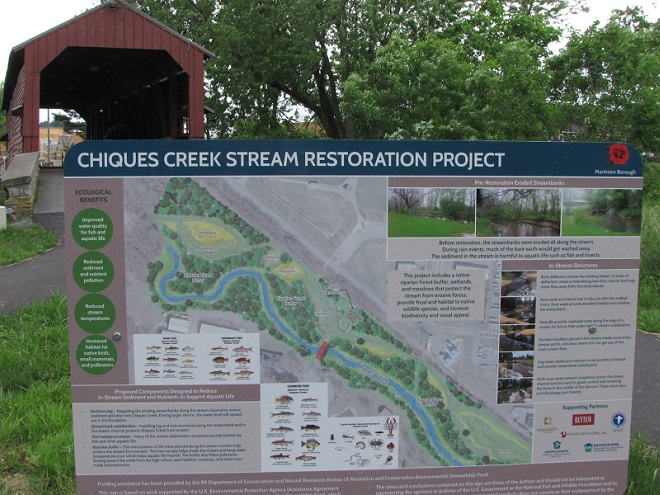
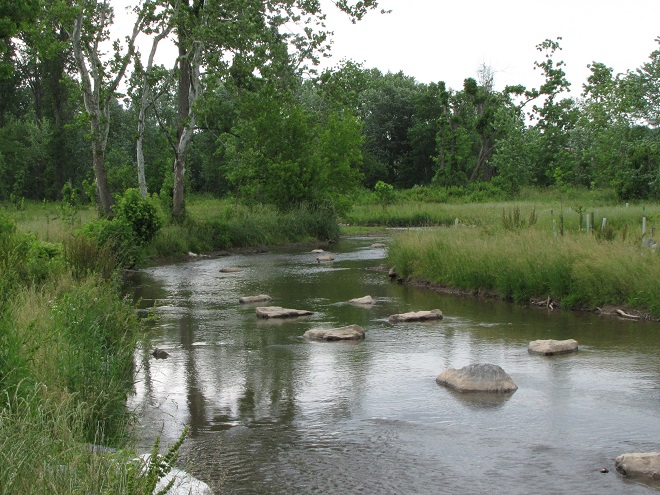
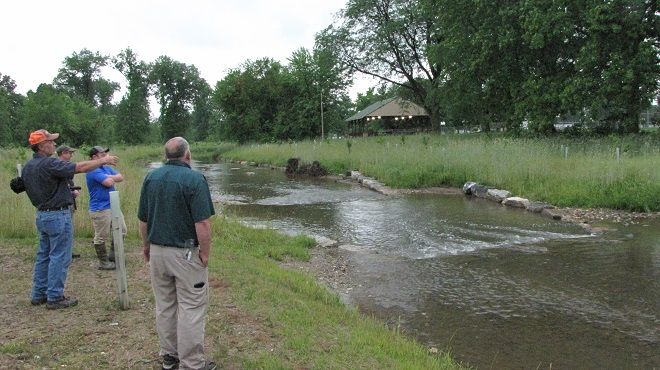
…and a highlight of the evening will be using an electrofishing apparatus to collect a sample of the fish now populating the rehabilitated segment of stream…
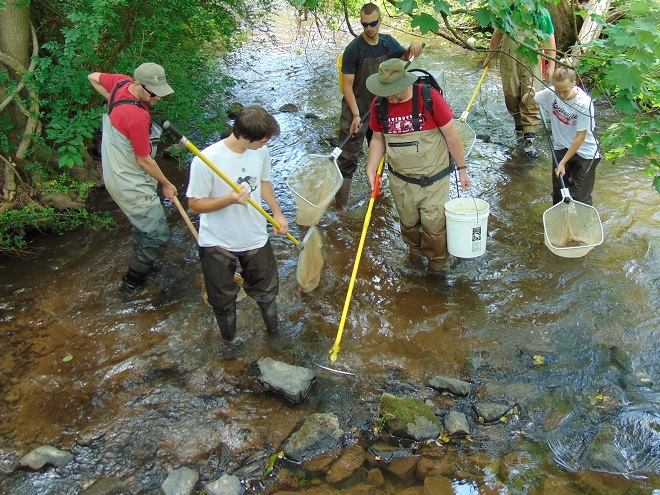
…so don’t miss it. We can hardly wait to see you there!
The 2023 Watershed Expo is part of Lancaster Conservancy Water Week.
Forty Years Ago in the Lower Rio Grande Valley: Day Twelve
Back in late May of 1983, four members of the Lancaster County Bird Club—Russ Markert, Harold Morrrin, Steve Santner, and your editor—embarked on an energetic trip to find, observe, and photograph birds in the Lower Rio Grande Valley of Texas. What follows is a daily account of that two-week-long expedition. Notes logged by Markert some four decades ago are quoted in italics. The images are scans of 35 mm color slide photographs taken along the way by your editor.
DAY TWELVE—June 1, 1983
“KOA Hammond, LA”
“We stopped early today — About 2:30 P.M. Cleaned the interior of the camper, washed the windows, and put everything where it belonged. The windshield was a buggy mess. Had supper according to the menu. Took pictures of the place. Had a shower. Loafed all evening.”
After being on the go for twelve to sixteen hours a day for more than a week, it was nice to catch up on our “housekeeping”, field notes, and rest. The campground, which was yet another nearly empty one, had an in-ground pool, so I decided to go for a swim. As I went through the gate, I noticed that the water was a little bit dull, not sparkling clear as if treated by the usual dose of chemicals. Upon getting closer, I could see what looked like a layer of mulm at the bottom of the pool, similar to the detritus and waste that accumulates atop the substrate in an otherwise clear aquarium tank. Needless to say, I postponed the swim. Later, when we happened to be in the office, I asked the owners about the pool and was momentarily puzzled when they told us that the entire campground had been flooded last month. This was at first surprising because no stream, creek, or river was in sight, but the land is so flat and the elevation so uniform in southwestern Louisiana that a couple of feet of water can inundate miles and miles of these lowlands. As on a beach or on a delta, building anything of value in a floodplain is risky business.
On June 2, we resumed our drive, then spent the night at the KOA campground in Sweetwater, Tennessee, at the same accommodations we visited while southbound on May 21. There, I finally had my refreshing swim. By the following evening, June 3, we had arrived back in Lancaster County, Pennsylvania. During the trip from the Brownsville Airport to Lititz, Pennsylvania, the odometer had registered 1,945 miles.
This then, prompted and fortified by the notes kept by Russ Markert, have been your editor’s recollections from his ever-evaporating river of memories of an adventure forty years gone. I hope you’ve enjoyed this modern-style slide show describing our journey to the Lower Rio Grande Valley. I’m grateful to each of my traveling companions for inviting me to share this experience with them and am equally glad to have had the opportunity to share the story of our trip with you.
If traveling to see the wildlife and plant communities of south Texas seems like something that might interest you, I strongly urge you to go. Many more tropical species, including native parrots, are now found north of the border and the opportunity to see vagrants is still better there than anywhere else in the country. The hundreds of species of butterflies and the spectacular migrations of the Neotropical birds that nest here in the the higher latitudes make it a place you need to visit at least once in a lifetime. The cooler months of the year can be a comfortable time to make the trip. You’ll see wintering birds from both eastern and western portions of the United States and Canada, some in numbers that might amaze you.
If the Lower Rio Grande Valley is something outside your means, then may I suggest a visit to ZooAmerica in Hershey, Pennsylvania. The theme of the collection is North American wildlife and the self-guided tour is organized by regional habitat types including the southern swamps and the southwestern deserts and scrubland. Some of the animals we saw on our expedition, and some that we missed, are among the species under their care.
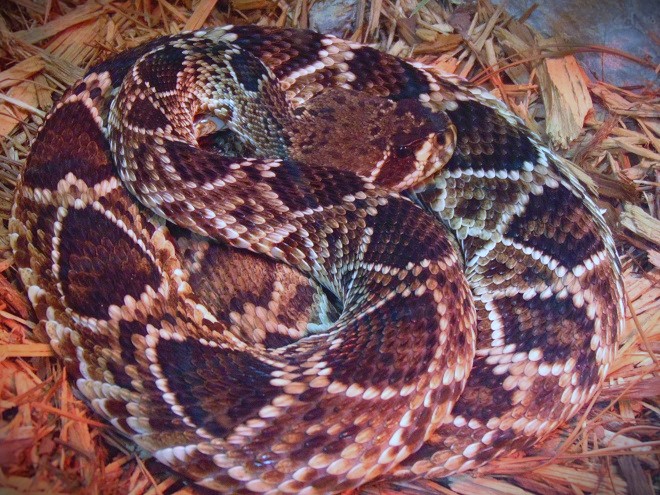
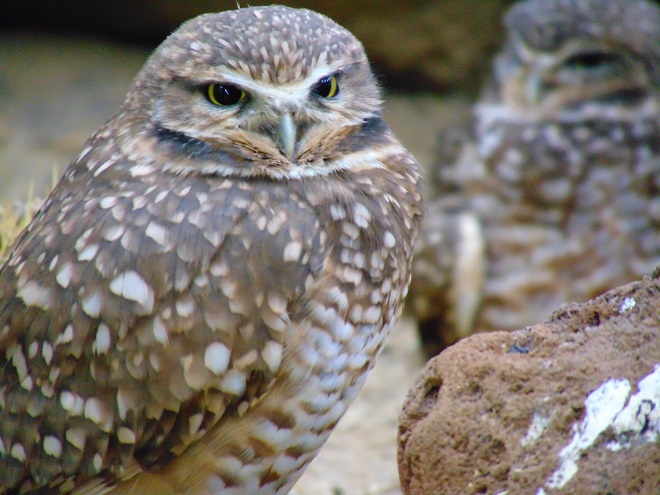
That’s it folks. Until next time, adiós amigos.
IN MEMORIAM
J. E. Russel Markert (1912-1984)
Harold B. Morrin (1924-2012)
Steven J. Santner (1948-2021)
Forty Years Ago in the Lower Rio Grande Valley: Day Eleven
Back in late May of 1983, four members of the Lancaster County Bird Club—Russ Markert, Harold Morrrin, Steve Santner, and your editor—embarked on an energetic trip to find, observe, and photograph birds in the Lower Rio Grande Valley of Texas. What follows is a daily account of that two-week-long expedition. Notes logged by Markert some four decades ago are quoted in italics. The images are scans of 35 mm color slide photographs taken along the way by your editor.
DAY ELEVEN—May 31, 1983
“AOK Camp, Texas — 7 Miles S. of Kingsville”
“Went south to the 1st rest stop south of Sarita — No Tropical Parula. Lots of other birds. We added Summer Tanager and Lesser Goldfinch.”
The Sarita Rest Area along Route 77 was like a little oasis of taller trees in the Texas scrubland. We received reports from the birders we met yesterday at Falcon Dam that recently, Tropical Parula had been seen there. We searched the small area and listened carefully, but to no avail. For these warblers, nesting season was over. We were surprised to find Lesser Goldfinches in the trees. Back in 1983, the coastal plain of Texas was pretty far east for the species. Steve was a bit skeptical when we first spotted them, but once they came into plain view, he was a believer. I recall him finally exclaiming, “They are Lesser Goldfinches.” Summer Tanager was another wonderful surprise. Today, the Sarita Rest Area remains a stopping point for birders in south Texas. Both Lesser Goldfinch and Tropical Parula were seen there this spring.
After our roll of dice at the Sarita Rest Area, we continued south through the King Ranch en route back to Brownsville.
“Saw a Coyote on the way.”
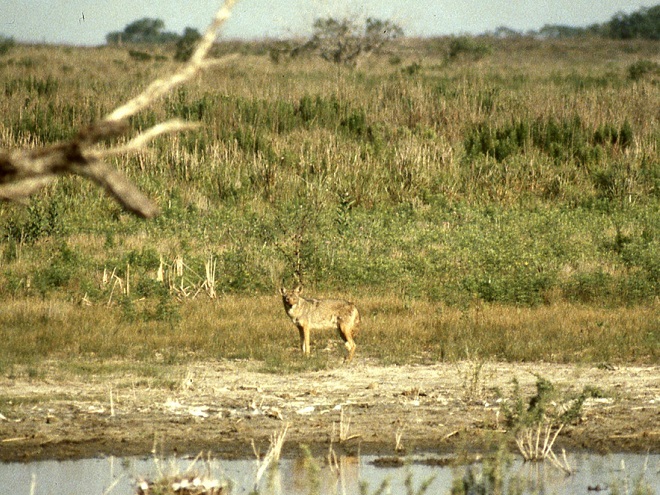
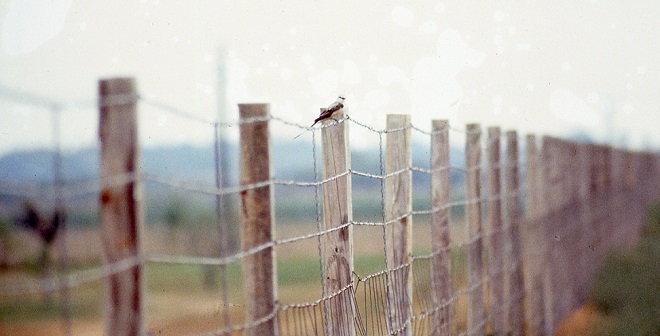
“Took Steve to the airport and drove out to Boca Chica where Harold went swimming.”
The drive from Brownsville out Boca Chica Boulevard to the Gulf of Mexico passes through about 18 miles of the outermost flats of the river delta that is the Lower Rio Grande Valley. This area is of course susceptible to the greatest impacts from tropical weather, especially hurricanes. During our visit, we passed a small cluster of ranch houses about two or three miles from the beach. This was the village known as Boca Chica. Otherwise, the area was desolate and left to the impacts of the weather and to the wildlife.
The mouth of the Rio Grande, and thus the international border with Mexico, was and still is about two miles south of Boca Chica Beach. Before the construction of dams and other flood control measures on the river, the path of the Rio Grande through the alluvium deposits on this outer section of delta would vary greatly. Accumulations of eroded material, river flooding, tides, and storms would conspire to change the landscape prompting the river to seek the path of least resistance and change its course. Surrounding the segments of abandoned channel, these changes leave behind valuable wetlands including not only the resacas of the Lower Rio Grande Valley, but similar features in tidal sections of the outer delta. When left to function in their natural state, deltas manage silt and pollutants in the waters that pass through them using ancient physical, biological, and chemical processes that require no intervention from man.
Harold was determined to go for a swim in the Gulf of Mexico before boarding a flight home. We all liked the beach. Why not? You may remember trips to the shore in the summertime. Back in the pre-casino days, we used to go to Atlantic City, New Jersey, to visit Steel Pier. For the first three quarters of the twentieth century, Steel Pier was the Jersey Shore’s amusement park at sea. There were rides, food stands, arcades, daily concerts with big name acts, diving shows, and ballroom dances.
There were, back then, attractions at Steel Pier that were creatively promoted to give the visitor the impression that they were going to see something more profound or amazing than was was delivered. You know, things advertised to draw you in, but its not quite what you expected.
For example, there was an arcade game promising to show you a chicken playing baseball. Okay, I’ll bite. Turns out the chicken did too. You put your money in the machine and watched as the chicken came out and rounded the diamond eating poultry food as it was offered at each of the bases. Hmmm…to suggest that this was a chicken playing baseball seems like a bit of a stretch.
They had a diving bell there too. Wow! We’ll go below the waves and view the fish, octopi, and other sights through the water-tight windows while we descend to the ocean floor. You would pay to get inside, then they would lower the bell down through a hole in the pier. Once below the rolling surf, you would get to look at the turbid seawater sloshing around at the window like dirty suds in a washing machine. If you were lucky, some trash might briefly get stuck on the glass. To imply that this was a chance to see life beneath waves was B. S., and I don’t mean bathysphere.
Then there was a girl riding a diving horse. You would hike all the way to the end of the pier and watch the preliminary show with these divers plunging through a hole in the deck and into the choppy Atlantic below. They were very good, but no, we never saw Rodney Dangerfield do a “Triple Lindy” there. And then it was time for the finale. Wow, is that horse going to dive in the ocean? How do they get the horse back up on the pier? Forget it. Instead of that, they walked poor Mr. Ed up a ramp into a box, then the girl climbs on his back, the door opens, and she nudges Ol’ Ed to into a plunge followed by a thumping splash into a swimming pool on the deck. Not bad, but not what we were expecting. Since we had to walk almost a quarter of a mile out to sea to get there, they kinda led us to believe that the amazing equine was going to leap into the Atlantic—horse hockey!
Preceding all this fun was a guy back in the early 1930s, William Swan, who, in June 1931, flew a “rocket-powered plane” at Bader Field outside Atlantic City. The plane was actually a glider on which a rocket was fired producing about 50 pounds of thrust to boost it airborne after assistants got it rolling by pushing it. In newspaper articles and on newsreels afterward, he would promote the future of rocket planes carrying passengers across the ocean at 500 miles per hour. Using a glider equipped with pontoons for landing in the ocean, he promised to make several flights daily from Steel Pier. Those who came to see him may have, at best, watched him fire small rockets he had attached to his craft—little more.
What does all this have to do with Boca Chica Beach? It turn out two years later, William Swan is hyping a new innovation—a rocket-powered backpack. He’d demonstrate it during a skydiving exhibition at the Del-Mar Beach Resort, a cluster of 20 cabins and community buildings on Boca Chica Beach. According to his deceptive promotions, Swan would jump out of a plane and light flares as he fell. Then he’d ignite the backpack rocket and land on the shoreline in front of the crowd. The event was expected to draw 3,000 carloads of people. When the big day came, just over 1,000 cars showed up. The event was a bust and the weather was bad, cloudy with a mist over the gulf. During a break in the clouds, the pilot took Swan aloft. Swan ordered him out to sea and to 8,500 feet, a higher altitude than planned. Then he jumped. He dropped the flares, which didn’t then ignite, and neither did the rocket. He opened his chute at 6,000 feet and the crowd watched as Swan drifted into the mist offshore and was never seen again. There were rumors both that he used the stunt as a way to flee to Mexico to start a new life and that he had committed suicide. Others believed he died accidentally. To learn the full story of Billy Swan, check out The Rocketeer Who Never Was, by Mark Wade.
Forward fifty years to our visit to Boca Chica Beach. The Del-Mar Beach Resort, built in the 1920s as a cluster of 20 cabins and a ballroom, was gone. It was destroyed by a hurricane later in the same year Swan disappeared—1933. The resort, which was hoped would be the start of a seaside vacation city, never reopened. In 1983, we saw just a handful of beach goers and the birds, that’s it. One could look down to the south and see the area of the Rio Grande’s mouth and Mexico, but there were no structures of note. It was peaceful and alive with wildlife. We were sorry we didn’t have more time there.
“Here we added Least Tern, Brown Pelican and Sandwich Tern.”
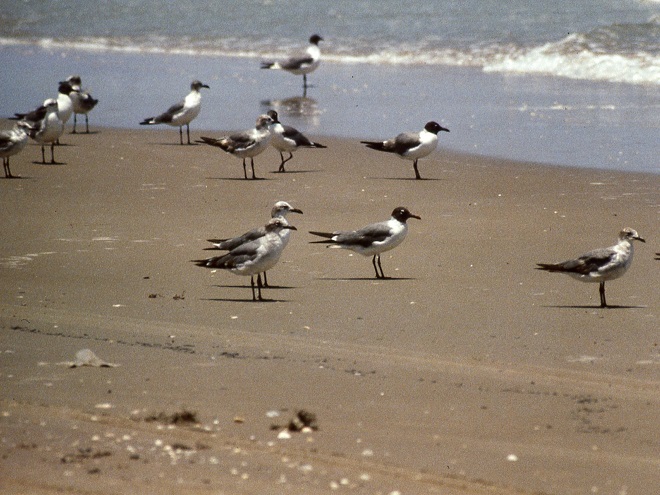
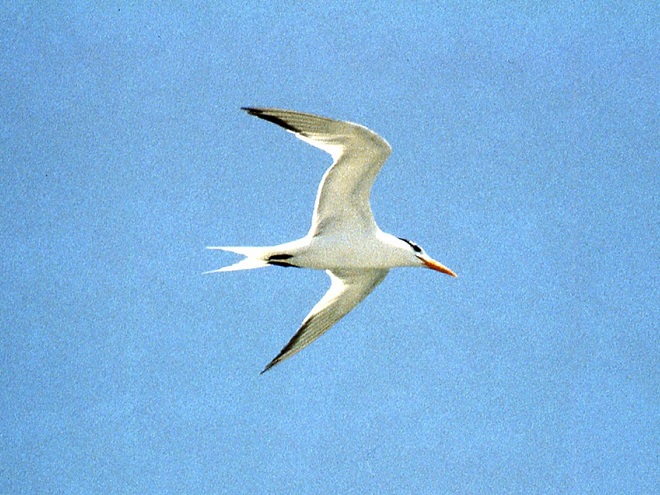

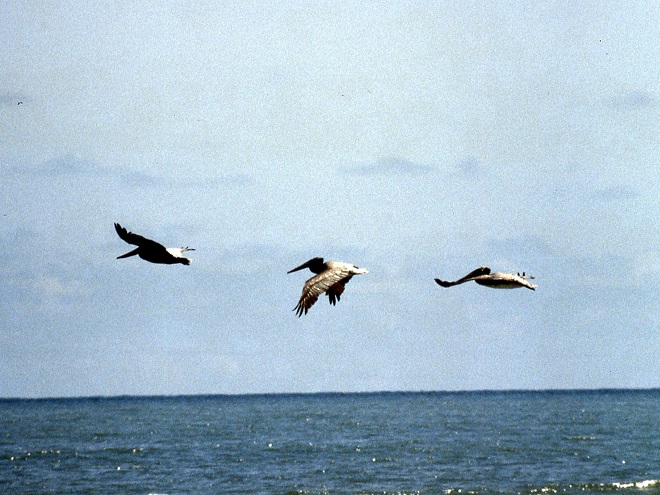
Today, the Village of Boca Chica and Boca Chica Beach are the location of SpaceX’s South Texas Launch Facility. Those of the village’s ranch houses built in 1967 that have survived hurricane devastation over the years have been incorporated into the “Starbase” production and tracking facility. The launch pad and testing area is along the beach just behind the dunes at the end of Boca Chica Boulevard.
The latest launch, just more than a month ago, was the maiden flight of “Starship”, a 394-foot behemoth that is the largest rocket ever flown. The “Super Heavy Booster” first stage’s 33 Raptor engines produce 17.1 million pounds of thrust making Starship the most powerful rocket ever flown. See, things really are bigger in Texas.
Last month’s unmanned orbital test launch ended when the Starship spacecraft failed to separate at staging. As the booster section commenced its roll manuever to return to the launch pad, the entire assembly began tumbling out of control. It exploded and rained debris into the gulf along a stretch of the downrange trajectory.
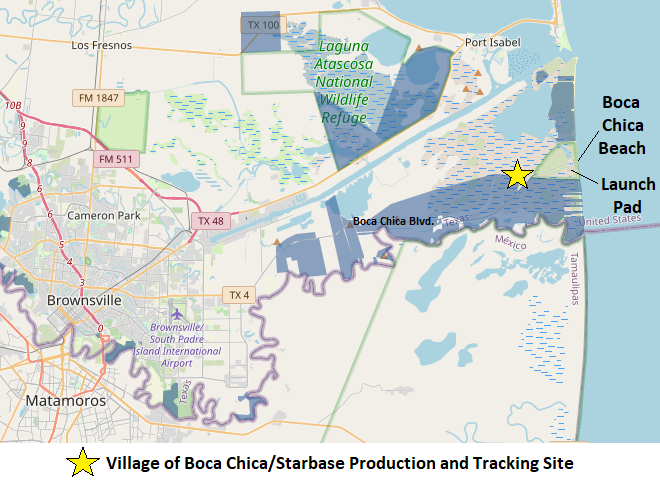
Development of Starbase is opposed by many due to noise, safety, and environmental concerns. Boca Chica Boulevard (Texas Route 4) is frequently closed due to activity at the launch pad site, thus excluding residents and tourists from visiting the beach. With over 1,200 people already working at Starbase, demand for housing in the Brownsville area has increased. Some have accused SpaceX CEO Elon Musk of promoting gentrification of the area—running up housing prices to force out the lower-income residents. He has responded with a vision of a new city at Boca Chica, his “space port”.
Does history have an applicable lesson for us here? When Musk talks about going to the Moon and Mars, or ferrying a hundred people around the world on his Starship, is it just another Steel Pier-style deception? Is Musk a modern-day William Swan? A very talented marketer? Could be. And is the whole thing setting up a large-scale replay of the Del-Mar Beach Resort’s demise in 1933? Is building a city on the outer edges of a river delta asking for an outcome similar to the one suffered by New Orleans during Hurricane Katrina? It’s likely. After all, building on or near a beach, floodplain, or delta is a short-sighted venture to begin with. If the party doing the developing doesn’t suffer the consequences of defying the laws of nature, one of the poor suckers in the successive line of buyers and occupants will. This isn’t rocket science folks. Its weather, climate, and erosion, and its been altering coastlines, river courses, and the composition and distribution of life forms on this planet for millions of years. And guess what. These factors will continue to alter Earth for millions of years more after man the meddler is long gone. You’re not going to stop their effects, and you’re not going to escape their wrath by ignoring them. So if you’re smart, you’ll get out of their way and stay there!
Billy Swan was probably broke when he came to Boca Chica. He reportedly borrowed 20 bucks from the resort operator just to cover his personal expenses during his backpack rocket event. Elon Musk comes to Boca Chica with over 100 billion dollars and capital from other private investors to boot. Despite some obvious exaggerations about colonizing the Moon, Mars, and other celestial bodies, he just might be able to at least get people there for short-term visits. And that’s quite an accomplishment.

“Then took Harold to the airport. We left him at 3:30 and headed north on Route 77, got as far as Victoria. Had a flat on the way. Larry had the spare on in 10 minutes. We stopped at a picnic area for the nite, because we could not find the camping area.”
If we were going to have a flat, we had it at the right place. We were just outside Raymondville, Texas, at a newly constructed highway interchange. The wide, level shoulder allowed us to get the camper off to the side of the road in a safe place to jack it up and change the tire. Easy. We were thereafter homeward bound.
Forty Years Ago in the Lower Rio Grande Valley: Day Ten
Back in late May of 1983, four members of the Lancaster County Bird Club—Russ Markert, Harold Morrrin, Steve Santner, and your editor—embarked on an energetic trip to find, observe, and photograph birds in the Lower Rio Grande Valley of Texas. What follows is a daily account of that two-week-long expedition. Notes logged by Markert some four decades ago are quoted in italics. The images are scans of 35 mm color slide photographs taken along the way by your editor.
DAY TEN—May 30, 1983
“Falcon Dam State Park, Texas”
“9:30 — Breakfast — The Pauraque sang all nite and the Mockingbird sang half the nite and interrupted my sleep.”
Before leaving the campground, we paid a final visit to the shores of the reservoir. We saw Anhinga and Little Blue Heron among the other water birds we had seen there previously.
“Now to the spillway again. We got lucky — A Green Kingfisher flew in and gave us great views. Cliff Swallows were plentiful. The Green Herons were fishing and so was a Kiskadee Flycatcher. Black Vultures were flying around. A Groove-billed Ani was very much in evidence.”
The little Green Kingfisher (Chloroceryle americana), after all the effort we finally saw one. It was just half the size of the Ringed Kingfisher we saw at the spillway one day earlier.
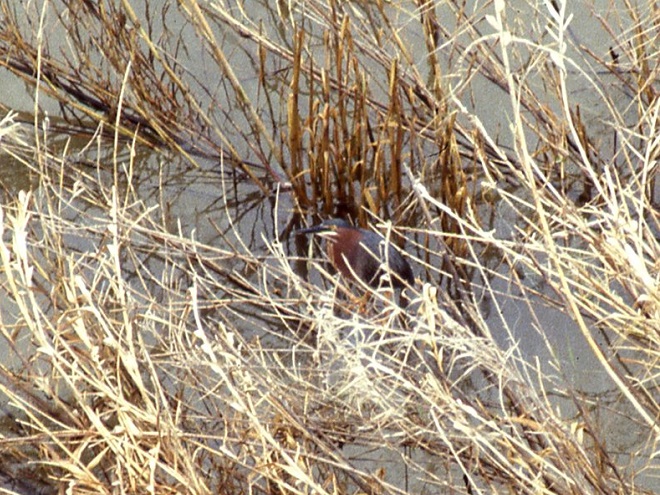
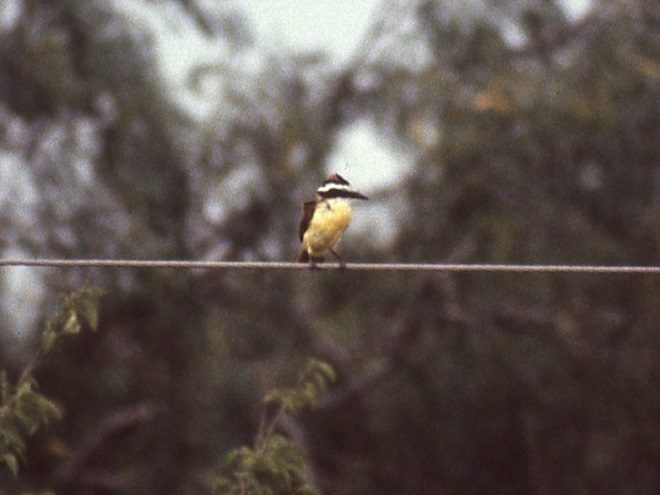
“Here we met Bill Graber from San Antonio. Ron and 3 women—Sandra from Wales, 1 from Oregon, and 1 from San Antonio… We all walked to the spot for the Ferruginous Owl”
We again followed Father Tom’s directions; “Park at spillway, walk the road to a fence, go right to the river, follow fence to a big dip (gully).”
Once in the designated area, several of us began searching around the vicinity for the owls. I was out of sight of the others and was examining a long procession of tropical leafcutter ants, possibly the Texas Leafcutter Ant (Atta texana). Their foraging trail had two single-file lanes—worker ants carrying dime-sized pieces of leaves to the nest and worker ants returning to the tree to harvest more. The ants’ path of travel stretched for more than one hundred feet down the limbs and trunk of the source tree, across the sandy ground, over a fallen log, across more sandy ground, through some leaf litter in the shrubs, and to the nest, where the foliage will be used to cultivate fungi (Lepiotaceae) for food. Thousands of worker ants were marching the route while others guarded their lines—fascinating.
Suddenly, I heard a commotion in the brush. Collared Peccaries (Dicotyles tajacu), also known as Javelina, on the run and headed right my way! The others must have unknowingly spooked them. In an instant I scrambled to my feet and bounded up the trunk of a willow tree that was strongly arching toward the river and had partially fallen after the bank had washed away. There I stood atop the nearly horizontal trunk as between 6 and 10 grunting peccaries bustled past in a cloud of dust. Just as fast as they had appeared, they were gone.
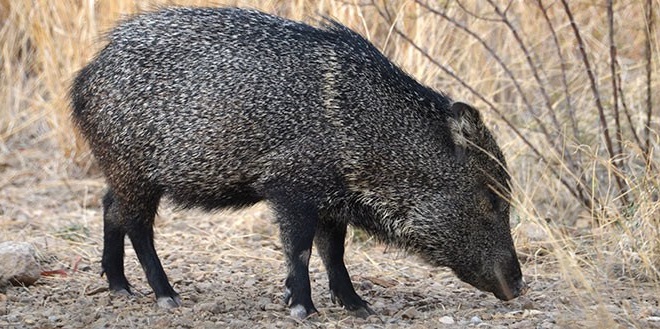
I walked back toward the gully and as I approached, I could see everyone peering at something in the dense foliage of the trees overhanging the river.
“…eventually Sandra spotted one coming in. Another was also seen in a much better position. We all saw the 2 black spots on the back of his head when he turned his head 180°. It looked like another face.”
They had found the Ferruginous Pygmy Owls, right where Father Tom said they would be. But they weren’t easy to see. And they were tiny. Make a loose fist—that’s about the size of a Ferruginous Pygmy Owl. We had to take turns standing at favorable places where there was a less-obstructed view of each bird. I’m not certain that anyone was able to get photographs. The shade was too dark for my equipment to get a favorable exposure. Such had been the case for many of the birds we found in the riparian forest. This owl was a life list species for everyone in our group and for most of the others. Like the Green Kingfisher, the owls were just barely within the A.B.A. area, on limbs stretching out above the waters of the Rio Grande.
“Then we came back to the picnic ground and walked the river’s edge for a 1/4 mile — Nothing extra, except an Altamira Oriole.”
I again did a little wading in the Rio Grande to cool down after spending hours in the hot scrubland/forest.
“On the way back to Brownsville, we stopped at Santa Margarita again with no Brown Jay luck.”
Though we never did bump into the roving band of Brown Jays at Santa Margarita Ranch, they were there, and they’re a species that’s still there today.
“On to Brownsville for good sightings of the Clay-colored Robin at the radio station.”
We returned to the radio transmitter site at Coria and Los Ebanos in Brownsville for yet another attempt to find Clay-colored Robins/Thrushes. After again securing permission from Mr. Wilson to have a look around, we at last had success and found a pair of Clay-colored Thrushes moving about in the boughs of the shade-casting tress and shrubs. With some persistence, we all got binocular views of these earth-tone rarities from Mexico.
While in Brownsville, we thought it a good idea to dabble a bit in the experiences of local consumer culture, so we drove downtown. After finding a place to park the camper, we commenced to going for an international stroll over the bridge that crosses the Rio Grande into Matamoras, Tamaulipas, Mexico. It was our first legal incursion south of the border. (In recent days, we may have stepped back-and-forth over the line a couple of times while wading in the river below Falcon Dam.)
Once in Matamoros, we entered the bank. Steve wanted to get some Mexican currency and coins for his collection, so we stepped inside. It was a typical classical-style masonry building like most banks built early in the twentieth century were, but this one had very few accoutrements inside. There was a big vault, some cash drawers, maybe a desk and a chair, and that was it. The doors were left open to get a flow of dirty air in the place because there was no air conditioning. No loan department or Christmas Clubs here, just dollars for pesos.
Upon leaving the bank and heading into the town, we were solicited by the unlicensed curbside pharmacists selling herbs and other home remedies. Not for me, I had one thing in mind on this shopping trip.
We walked up the street to step inside some of the numerous tourist shops—stuff everywhere. The other men bought a few post cards. For a friend back home, I bought a key chain with a tiny pair of cowboy boots attached. Having heard that cowboy boots could be had for cheap south of the border, he had given me his size requirements and asked that I should get him a pair if the price was right. Well, the price wasn’t that great in the tourist town section of the city, so I got him the key chain instead.
After about an hour, we were headed back over the bridge into Brownsville. Along the pedestrian walkway, there was a United States Customs checkpoint one had to pass before entering the country. The customs officer asked the usual questions and after telling him we were only in Mexico for an hour, he queried, “Did you buy anything that you’re bringing back into the country.” Having an item to declare, I told him yes, I bought a pair of cowboy boots. He looked down at my rubber-toed canvas sneakers, then looked at Russ, Harold, and Steve, who obviously weren’t carrying or wearing boots, and he snapped, “Where are they?” I pulled the wax paper bag with the key chain inside from my pocket. He called me a smart ass and waved us on. We chuckled.
The only bird species seen during or short trek into Matamoros? House Sparrow.
In the forty years since our visit to the Rio Grande Valley, the rate of northbound human migration across the river, and particularly the amount of smuggling activity that uses the migration as a diversion to cover its operations, has surely taken the fun out of being on the border. Many of the places we visited are no longer open to the public, or access is restricted and subject to tightened security. Santa Margarita Ranch, for example, now allows guided tours only. Falcon Dam changed its security practices after one of a pair of opposing drug cartels escalated their mutual dispute by planting explosives there—threatening to blow it up to hamper crossings by its opponent’s smugglers in the fordable waters downstream.
Fortunately for today’s birder, many of the tropical specialties have inched their range north of the Rio Grande’s banks and can be found on accessible public and private lands outside the immediate tension zone. National Wildlife Refuges and Texas State Parks provide access to some of the best habitats. Places like the King Ranch even offer guided bird and wildlife tours on portions of their vast holdings where many border species including Ferruginous Pygmy Owl, Crested Caracara (Caracara plancus), Green Jay, Vermillion Flycatcher (Pyrocephalus obscurus), Northern Beardless-Tyrannulet (Camptostoma imberbe), and the tropical orioles are now found. So don’t let the state of dysfunction on the border stop you from visiting south Texas and its marvelous ecosystems. It’s still a birder’s paradise!
“We ate supper at Luby’s Cafeteria and headed north on Route 77 for the Tropical Parula.”
Harold was very pleased to have added Hook-billed Kite, Ferruginous Pygmy Owl, and Clay-colored Thrush to his A.B.A. life list, so he offered to buy dinner. After visiting a mail box to get a few postcards on their way, we ate at Luby’s Cafeteria in Brownsville, which was an interesting experience for that time period. Luby’s was a regional restaurant chain. You could get in line there and select anything you wanted, then pay for it by the item. Luby’s predated the all-you-can-eat salad bar and buffet craze that would sweep the restaurant industry in coming years. Under the circumstances, it was perfect for us. After not eating much all week due to the hot, humid conditions that accompanied the unusually rainy weather, our appetites begged satisfaction—but the heat hadn’t relented, so we didn’t want to overdo it. The staff at Luby’s didn’t blink an eye at us entering the restaurant wearing field clothes. It was the first climate-controlled space we had enjoyed all week—very refreshing. We really enjoyed the experience and it recharged us all.
Near Raymondville along Route 77, a set of electric wires strung on tall wooden poles paralleled the highway. These poles were hundreds of yards away from road, but seeing a raptor atop one, we stopped and got out the spotting scope. It was yet another south Texas specialty, a White-tailed Hawk (Buteo albicaudalus), a bird of grassland and brush. Its range north of Mexico is limited to an area of Texas from the Lower Rio Grande Valley north through the King Ranch to just beyond Kingsville. A short while later, we saw one or two more on our way through the King Ranch.
“Saw a flock of White-rumped Sandpipers when we stopped for gas.”
Lest one might think that traveling through parts of five south Texas counties to go from Falcon Dam back east through the Lower Rio Grande Valley to Brownsville and then north for a return stay at the A.O.K. campground is just another day of birding punctuated by some driving every now and again, consider the mileage racked up on the odometer today—259 miles. Even the counties are bigger in Texas.
We topped off the fuel tank at a service station near Sarita, Texas, and saw the White-rumped Sandpipers (Calidris fuscicollis) in a pool of rainwater among the scrubland at roadside.
“We stopped at the AOK Camp Ground 7 miles south of Kingsville and will return to get the parula at the first rest stop south of Sarita. Now 9:30 CDST.”
WHY WORRY ABOUT SPIDERS AND SNAKES?
Back at the old A.O.K. campground, this time with Harold and Steve, we decided to have a camp fire for the first time on the trip. We bought a bundle of wood at the camp office and soon had it crackling. I broke out the harmonica, but knowing no cowboy tunes, soon stashed it away. We had better things to do. Did we bake some beans in an iron kettle on the hot embers? No, we ate plenty at Luby’s. Did we toast marshmallows on sticks and make s’mores? Nope. Did we roast our weenies and warm our buns? No, not that either. We simply sat around recapping our trip while scratching our itchy ankles. Seems each of us was hosting chigger larvae and these parasites, upon maturing to nymphs and departing, left irritating wounds in our skin where they had been feeding—right in the hollow of our ankles.
Chiggers (Trombiculidae), like spiders and ticks, are arachnids. They thrive in humid environments as opposed to arid climes. Our best guess was that we had picked them up while hiking around in the subtropical riparian forests along the Rio Grande in the early days of the trip. My wounds eventually left little red pimples where each tiny larva had been feeding. They healed about a week after I got home. Due to the severity of his wounds, Steve cancelled a second week of his trip. On his own, he was going to continue west along the Rio Grande to the area of Big Bend National Park, but instead booked a flight home. Chigger larvae are stealthy little sneaks—we never had any clue they got us until they were gone. So why worry about spiders and snakes?
Forty Years Ago in the Lower Rio Grande Valley: Day Nine
Back in late May of 1983, four members of the Lancaster County Bird Club—Russ Markert, Harold Morrrin, Steve Santner, and your editor—embarked on an energetic trip to find, observe, and photograph birds in the Lower Rio Grande Valley of Texas. What follows is a daily account of that two-week-long expedition. Notes logged by Markert some four decades ago are quoted in italics. The images are scans of 35 mm color slide photographs taken along the way by your editor.
DAY NINE—May 29, 1983
“Falcon Dam State Park, Texas”
“To the spillway area after breakfast and saw Ringed Kingfisher, Baird’s Sandpiper, and 2 Black-necked Stilts. Stopped to photograph the Swainson’s Hawk which had flown in a tree. Also saw a Blue Grosbeak.”
The Ringed Kingfisher (Megaceryle torquata) was notably larger than the Belted Kingfishers with which we were so familiar, so it was easy to identify. This was yet another tropical species found north only as far as the Rio Grande Valley of Texas. Baird’s Sandpiper was a pretty good find for this location in late May.

“We drove to Santa Margarita Ranch to search for the elusive Brown Jay.”
While en route to Santa Margarita Ranch, we stopped twice to photograph birds we spotted along the way.
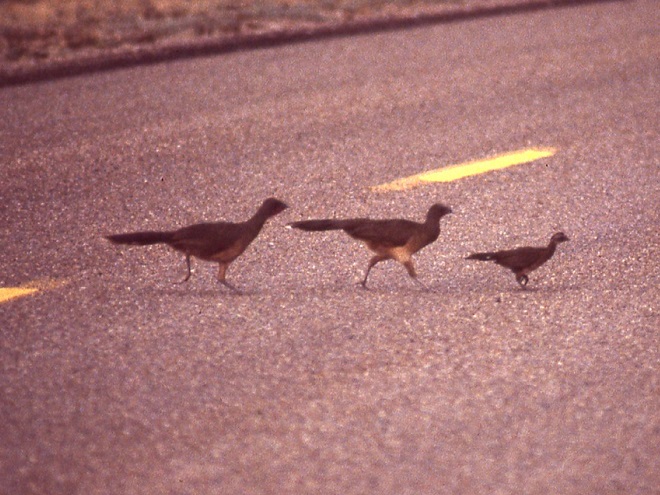
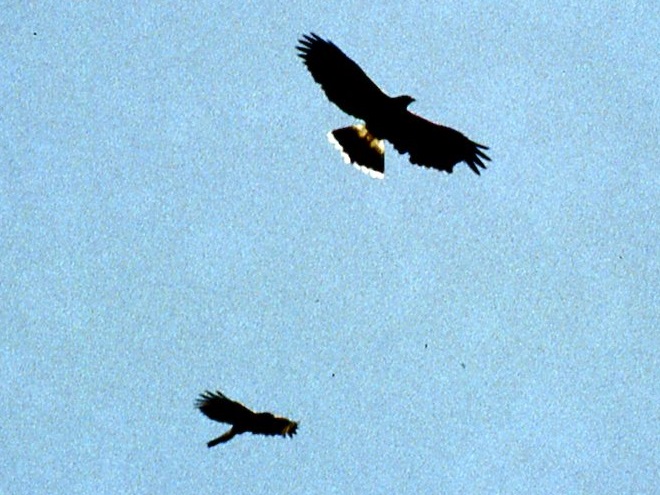
Beside the road just outside the entrance to the ranch, we observed a Verdin (Auriparus flaviceps), a tiny chickadee-like like bird with a yellow head and throat. Verdins reside in both thornscrub and desert throughout the southwestern United States and northern Mexico.
“Rancho Santa Margarita is a group of 8 houses. Cattle roam at will. We walked a long way along the river — No luck. Had lunch in the camper and repeated the morning walk. Cattle dung all over the place. The dung rollers were as interesting to watch as the leaf-carrying ants. Met a Mr. McQueary who had seen them 30 min. ago, so he led us to where he had seen them, but — No luck.”
Upon arriving at Santa Margarita Ranch intending to find Brown Jays (Psilorhinus morio), we drove over the in-ground cattle gate at the entrance and back the dirt driveway to the small cluster of houses where we parked. We checked in with a resident there and slipped them a dollar or two a head for letting us spend the day on their land. As we walked away from the houses, we noticed some intermittent movement in a pile of construction debris along the dirt road leading to the river. Initially thinking we may have caught glimpses of some small rodents dashing around, we watched patiently until we saw at least two Blue Spiny Lizards (Sceloporus cyanogenys) among the lumber and tin. The pair was obviously finding insects or other sources of prey there
To find Brown Jays, one of the five target species of the trip, Father Tom had advised us to follow the advice in James Lane’s A Birder’s Guide to the Rio Grande Valley of Texas. The recommendations contained therein brought us to Santa Margarita Ranch. As was the case upriver near Falcon Dam, the Tamaulipan Saline Thornscrub that covers much of the property turns abruptly to subtropical riparian forest near the banks of the Rio Grande where wetter soils predominate. The habitat was excellent, and we were certain the birds were there, but despite significant effort, we just couldn’t bump into Brown Jays at Santa Margarita Ranch.
We did however get good looks at another Hook-billed Kite sailing above the trees downriver. During our second walk, Harold, Steve, and I waded down a short section of the Rio Grande in hopes of getting better looks into an area of shoreline forest too thick to enter by land. Despite recent rains, the water was low, restricted by gates at Falcon Dam to little more than the flow needed to operate the turbines and generate electricity. We saw orioles, Red-billed Pigeon, and Great Kiskadee—but no Brown Jays.
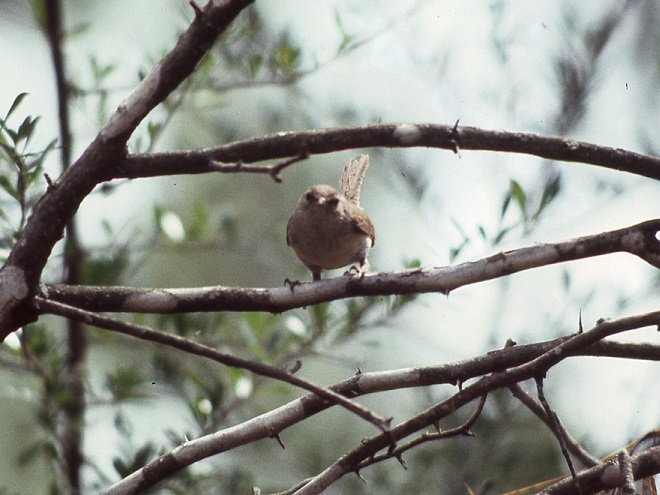
“On the way out…found a nest of Pyrrhuloxia and saw a 6 ft. snake hanging from a bush with a rabbit in his mouth. The snake caught the rabbit by the shoulder and it was working hard to get free. Finally the snake dropped the rabbit, and they both went out of sight.”
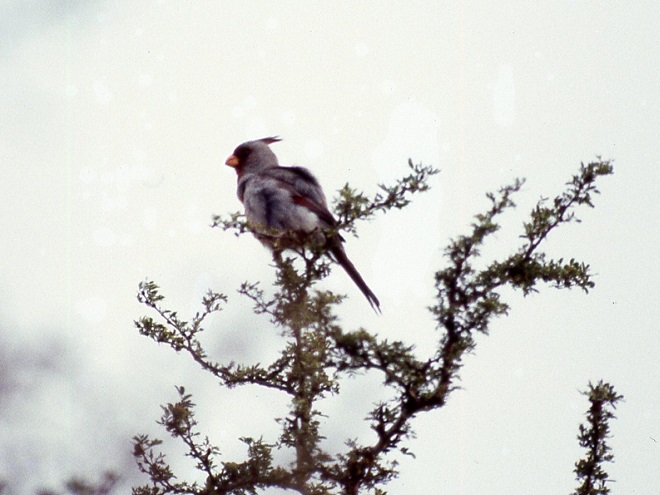
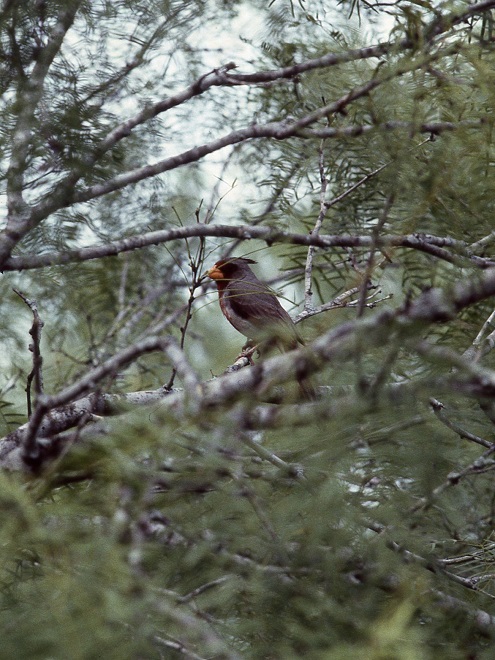
As we eased our way out the dirt road at Santa Magarita Ranch, we began hearing a blood-curdling series of squeals. Russ stopped the van and as we peered into the thornscrub, we could catch glimpses of an Eastern Cottontail thrashing around. At first we thought it had somehow become snagged in the quagmire of prickles on the dense vegetation. Then we spotted the snake draped over the shrubs and attempting in vain to lift the cottontail off the ground. The struggle, and the squealing, continued for several minutes as we labored to identify the snake. As the snake attempted to reposition the cottontail so that it could swallow it head first, the rabbit broke free and escaped. All was silent as the snake quickly fled as well. As it slithered away we could see just how long it really was—5 to 6 feet or more. You know, things really are bigger in Texas. Based upon its large size, overall tan-brown color, and the rapid speed with which it left the scene, we determined it was a Western Coachwhip (Masticophis flagellum testaceus).
“Back to the spillway at Falcon Dam — No luck. Met Ron Huffman who is leading a trip for 3 women. We will meet him at the spillway tomorrow AM early. Back at our camp site for supper — shower and shave. The Lesser Nighthawks were trilling late in the evening.”
During the evening, we found Black-throated Sparrow (Amphispiza bilineata) and Scaled Quail (Callipepla squamata) in the area of the campsite. Then, as darkness settled in, the calls of Common Pauraque, Common Nighthawks, and Lesser Nighthawks (Chordeiles acutipennis) commenced. We walked down the road to a spot where we could overlook a lower-lying area of thornscrub in hopes of catching a glimpse of some of these nightjars, particularly the latter species, as they patrolled for flying insects. But under cloudy skies and being miles from any man-made sources of light, it was too dark to see anything flying around.
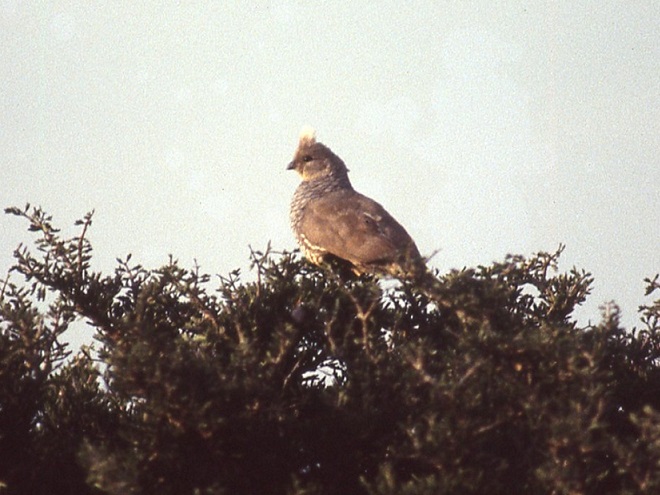
Forty Years Ago in the Lower Rio Grande Valley: Day Eight
Back in late May of 1983, four members of the Lancaster County Bird Club—Russ Markert, Harold Morrrin, Steve Santner, and your editor—embarked on an energetic trip to find, observe, and photograph birds in the Lower Rio Grande Valley of Texas. What follows is a daily account of that two-week-long expedition. Notes logged by Markert some four decades ago are quoted in italics. The images are scans of 35 mm color slide photographs taken along the way by your editor.
DAY EIGHT—May 28, 1983
“Bentsen State Park, Texas”
“Alarm at 6:00 A.M. After breakfast we traveled to Falcon State Park and toured the whole camp area, stopping many places to observe birds. We ran up a good list.”
And so we left what had been our home for the last several days and headed west. In the forty years since our departure that morning, Bentsen-Rio Grande State Park has experienced a number of operational changes. Today, it is a World Birding Center site. For conducting the seasonal hawk census, a tower has been erected to provide counters and observes with an unrestricted view above the treetops. If you wanted to camp in the park now, you would need reservations and would have to hike your gear in to one of only a few primitive campsites. Trailer and motor home accommodations no longer exist. A tram service is now available for touring the park by motor vehicle.
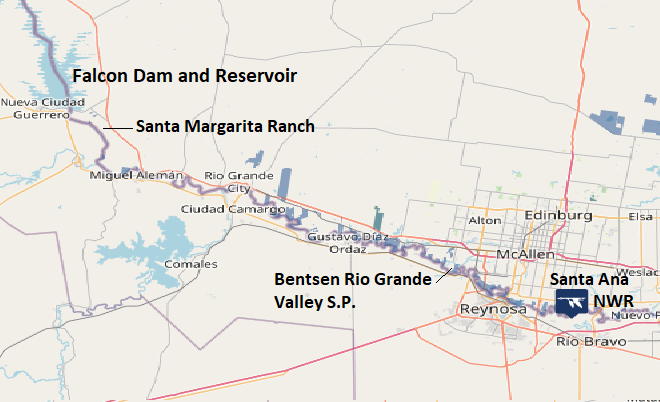
Falcon State Park is located along the east shore of Falcon Reservoir. There are no shade trees beneath which one can escape the scorching rays of the sun on a hot day. This is the easternmost section of the scrubland’s Tamaulipan Saline Thornscrub, a xeric plant community of head-high brush found only on clay soils with a particularly high salinity. Many of the plants look similar to other varieties of shrubs and small trees with which one may be familiar, except nearly all of them are covered with nasty thorns and prickles. And yes, there are cactus. You can’t make your way bushwhacking cross country without obtaining cuts, gashes, and scars to show for it. The Falcon State Recreation Area bird checklist published in 1977 has a nice description of the plants found there—mesquite, ebano, guaycan, blackbrush and catclaw acacia, granjeno, coyotillo, huisache, tasajillo, prickly pear, allthorn, cenizo, colima, and yucca. In the margins between the thornscrub growth, there is an abundance of grasses and wildflowers. On nearby ridges, Tamaulipan Calcareous Thornscrub, a similar xeric plant community, occupies soils with a higher content of calcium carbonate. Together, these communities comprise much of the Tamaulipan Mezquital ecoregion of scrublands in Starr County and western Hidalgo County in the Rio Grande valley of Texas.
After being greeted by a Greater Roadrunner at the campsite, we took a walk to the nearby shoreline of the reservoir. We spotted Olivaceous Cormorants perched on some dead limbs in the water nearby. Known today as Neotropic Cormorant (Phalacrocorax brasilianus), it is yet another specialty of the Rio Grande Valley. Elsewhere on or near the water—Cattle Egret, Great Egret, Black-bellied Whistling Duck, Osprey, Common Gallinule, Killdeer, Laughing Gull, Forster’s Tern (Sterna forsteri), Least Tern, and Caspian Tern were seen.
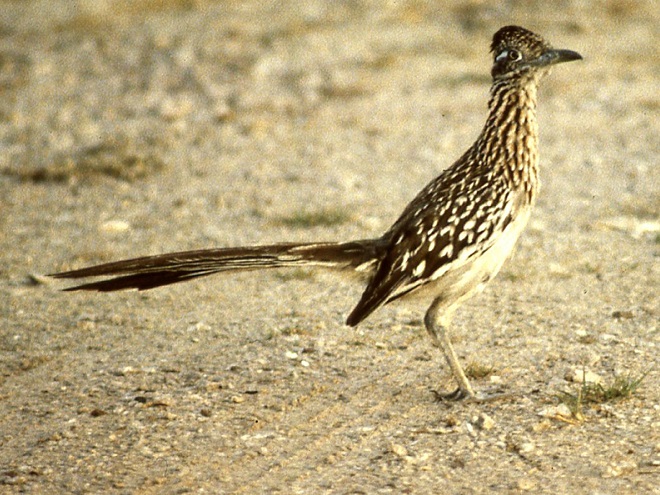
In the thornscrub around the campground, which, like Bentsen-Rio Grande State Park, we had pretty much to ourselves, we saw Scissor-tailed Flycatcher, Curve-billed Thrasher, White-winged Dove, Mourning Dove, Ground Dove, Inca Dove, and White-tipped Dove. A single Chihuahuan Raven was a fly by. We saw and smelled several road-killed Nine-banded Armadillos (Dasypus novemcinctus), but never found one alive.
Then, it started to rain. Not just a shower, but a soaker that persisted through much of the day. Rainy days can make for great birding, so we kept at it. Unfortunately, such days aren’t too ideal for photography, so we did only what we could without ruining our equipment.
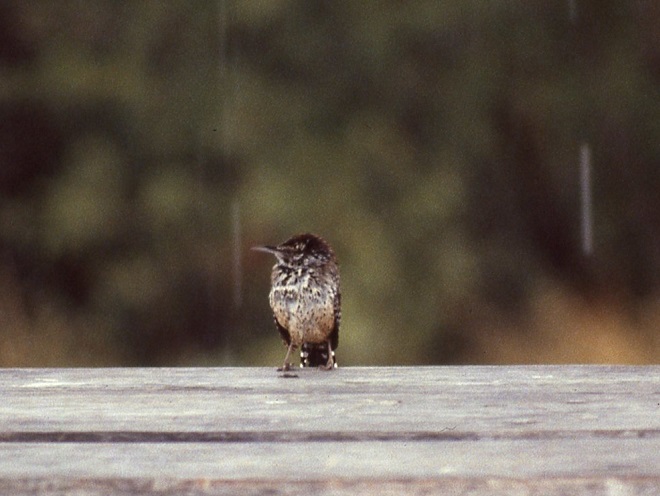
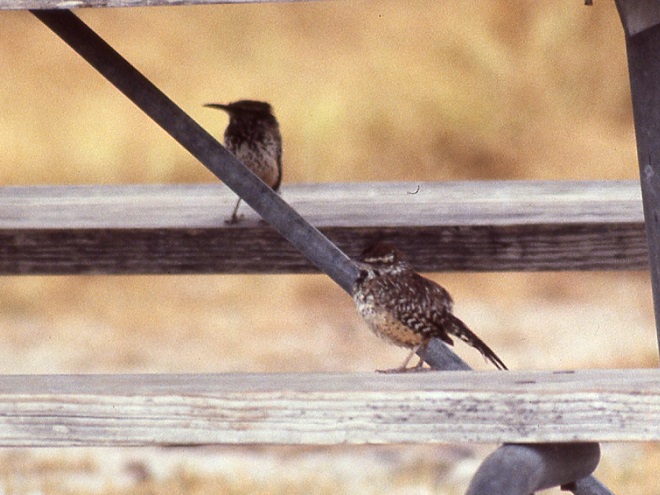
“Finally we drove to the spillway of the dam and parked.”
Falcon Dam was another of the numerous flood-control projects built on the Rio Grande during the middle of the twentieth century. Behind it, Falcon Reservoir stores water for irrigation and operation of a hydroelectric generating station located within the dam complex. Construction of the dam and power plant was a joint venture shared by Mexico and the United States. The project was dedicated by Presidents Adolfo Ruiz Cortines and Dwight D. Eisenhower in 1953.
Rainy days aside, the route precipitation takes to reach the Falcon Reservoir and the Lower Rio Grande Valley includes hundreds of miles through arid grasslands and scrublands. Along the way, much of that water is lost to natural processes including evaporation and aquifer recharge, but an increasing percentage of the volume is being removed by man for civil, industrial, and agricultural uses. Can the Rio Grande and its tributaries continue to meet demand?
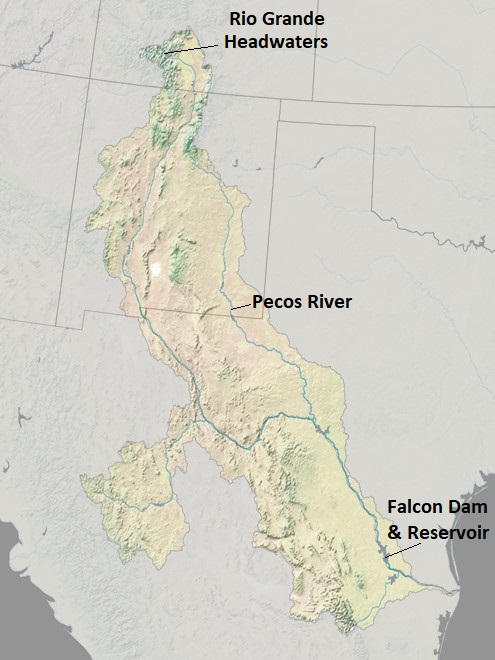

“On the way in we saw and photographed an apparent sick or injured Swainson’s Hawk. We approached it very close.”
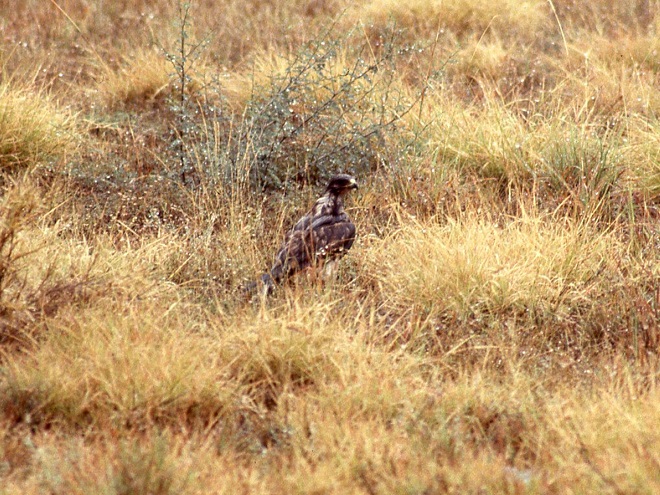
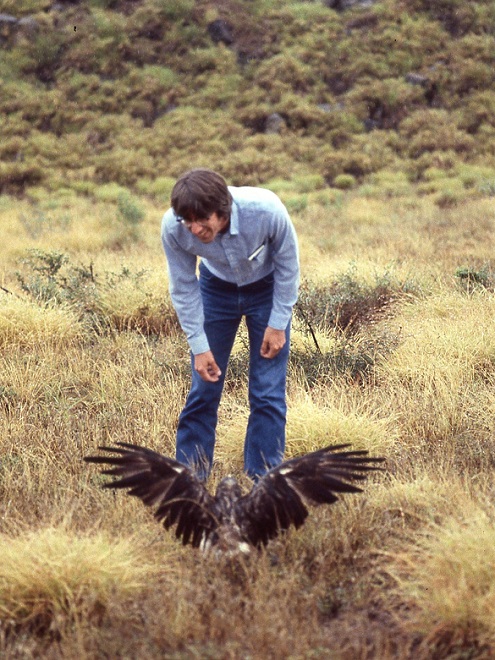
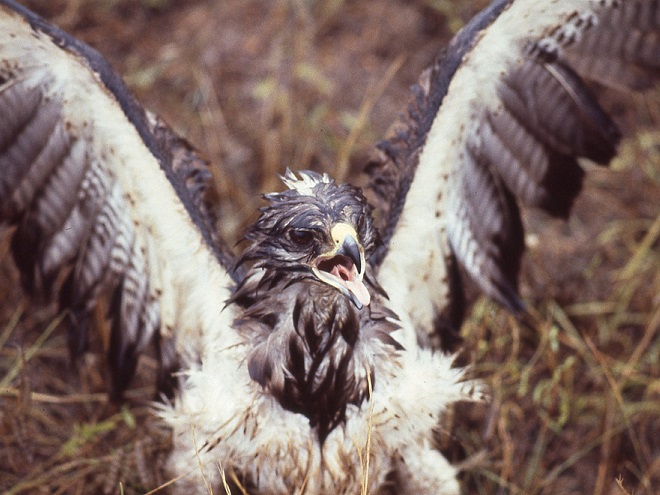
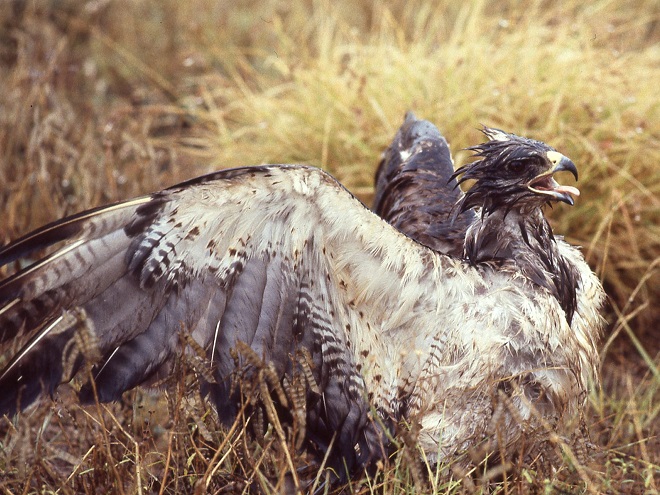
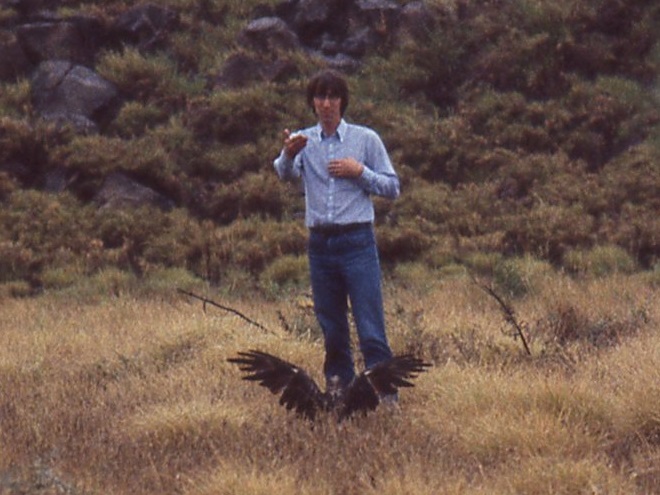
“At the spillway we sat in the camper, except when the rain slackened, then we stood out and watched in vain for the Green or Ringed Kingfisher, which we never did see.”
At the spillway House Sparrows, Rough-winged Swallows, and Cliff Swallows were nesting on the dam, the latter two species grabbing flying insects above the waters of the Rio Grande.
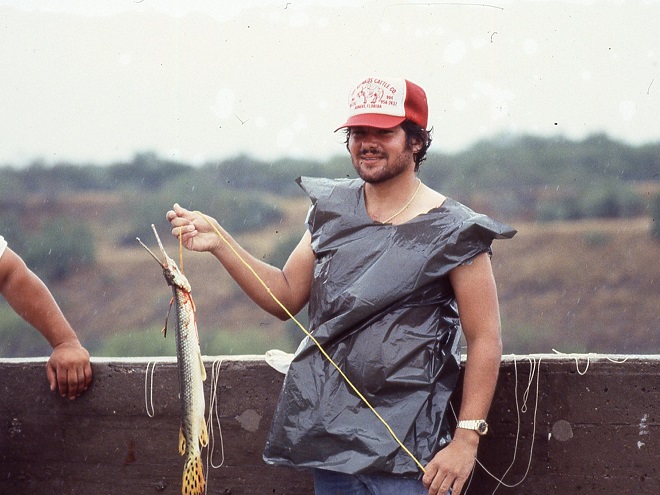
“I made dinner here at this spillway and we continued to watch. The rain almost stopped, so we walked down the road about 1 1/2 miles, during which time we saw a lifer for Harold — Hook-billed Kite. We followed Father Tom’s directions to a spot for the Ferruginous Owl — no luck.”
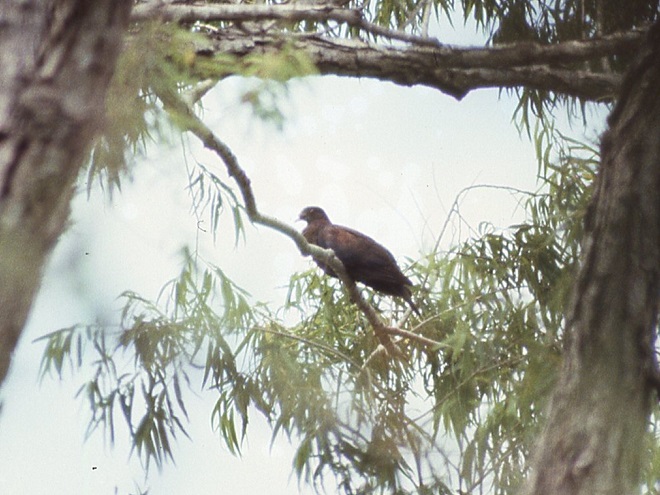
“Back at the spillway we had supper and then repeated the hike — no Ferruginous Owl, but a Barn Owl and Great Horned Owl. Back to our #201 campsite and wrote up the day’s log.”
Trees along the river provided habitat for orioles and other species. Since the rain had subsided, we decided to see what might come out and begin feeding. Soon, we not only saw an Altamira Oriole, but found Hooded Oriole (Icterus cucullatus) and the yellow and black tropical species, Audubon’s Oriole (Icterus graduacauda), formerly known as Black-headed Oriole. Three species of orioles on a backdrop of lush green subtropical foliage, it was magnificent.
Along the dirt road below the dam, the mix of scrubland and subtropical riparian forest made for excellent birding. We not only found a soaring Hook-billed Kite, one of the target birds for the trip, but we had good looks at both a Great Horned Owl, then a Barn Owl (Tyto alba) that we flushed from the bare ground in openings among the vegetation as we walked the through. Both had probably pounced on some sort of small prey species prior to our arrival. Because there are seldom crows or ravens to bother them, owls here are more active during than day than they are elsewhere. The subject of this afternoon’s intensive search, the elusive and diminutive Ferruginous Pygmy Owl (Glaucidium brasilianum), is routinely diurnal. Other sightings on our two walks included Turkey Vulture, Black Vulture, White-tailed Kite, Northern Bobwhite, Yellow-billed Cuckoo, Golden-fronted Woodpecker, Ladder-backed Woodpecker, Couch’s Kingbird, Brown-crested Flycatcher, Green Jay, Black-crested Titmouse, Mockingbird, Long-billed Thrasher, Great-tailed Grackle, Bronzed Cowbird, Northern Cardinal, and Painted Bunting.
The day finished as so many others had earlier during the trip—with insect-hunting Common Nighthawks calling from the skies around our campsite.
Forty Years Ago in the Lower Rio Grande Valley: Day Seven
Back in late May of 1983, four members of the Lancaster County Bird Club—Russ Markert, Harold Morrrin, Steve Santner, and your editor—embarked on an energetic trip to find, observe, and photograph birds in the Lower Rio Grande Valley of Texas. What follows is a daily account of that two-week-long expedition. Notes logged by Markert some four decades ago are quoted in italics. The images are scans of 35 mm color slide photographs taken along the way by your editor.
DAY SEVEN—May 27, 1983
“Bentsen State Park”
“6 A.M. alarm rang. After breakfast we walked an hour or more. At 8:15 we phoned Father Tom for more information. We next went back to Anzalduas County Park in hopes of seeing a Hook-billed Kite. It is now 11:30 and NO luck. Steve got his first lifer — Red-billed Pigeon. We parked on a dirt dike and they went walking. I took a nap.”
Based on new tips from Father Tom, we had back-tracked east along the Rio Grande to look for Hook-billed Kite, Red-billed Pigeon (Patagioenas flavirostris), and other species before continuing west toward Falcon Dam in coming days. The pigeon was yet another specialty with a range that extends north from Central America into the subtropical riparian forests of the Lower Rio Grande Valley.
Anzalduas County Park is located along the Rio Grande at the Anzalduas Diversion Dam, part of a network of flood control projects initiated in the 1930s to reign in the “untamed river”. Construction on this particular dam began in 1956 and was completed in 1960. Operation of diversion and flood control dams on the Rio Grande has functionally eliminated stream meander along its present course, thus the delta that is the Lower Rio Grande Valley will cease to experience the morphological changes that create wetlands, resacas, and other natural features in the floodplain. Thought to be excellent ideas at the time, most of these projects were based on a blurred vision of the connection between streams, their floodplains, and the watershed’s aquifer. This condition has manifested itself as a blindness to the finite nature of water supplies, particular where consumption rates are still sharply rising while groundwater recharge is diminishing.
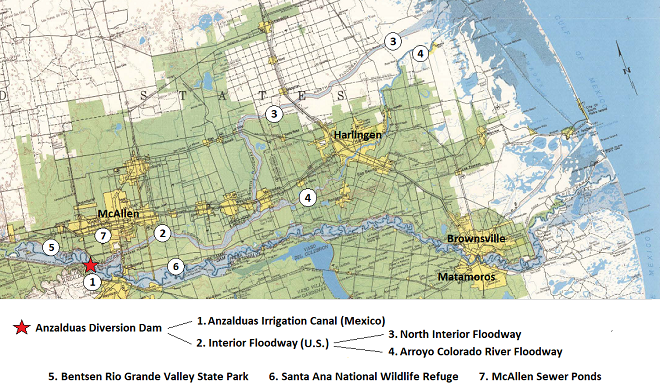
In addition to the Red-billed Pigeon, we found Brown-headed Cowbirds at Anzalduas County Park. Flying over the adjacent reservoir/river there were Caspian Terns. We identified some turtles too—Red-eared Sliders.
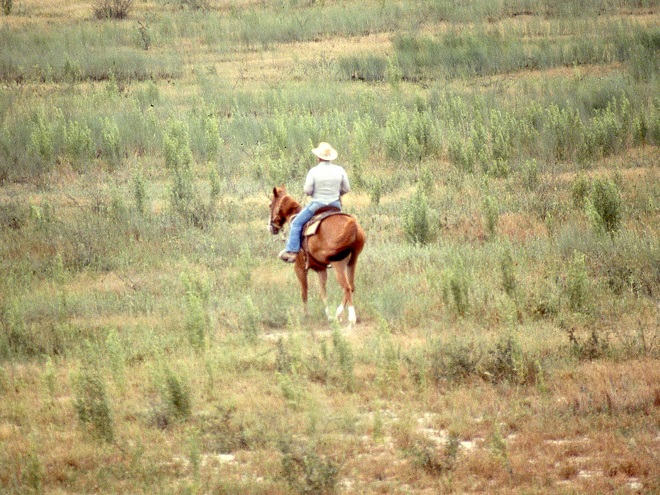
“After my nap, I took pictures of the place and of the men coming back. Then to the McAllen Sewage Ponds where we had some luck — Eared Grebe and others.”
The McAllen Sewage Ponds were like a little oasis for waterbirds. Though not a specialty of the Lower Rio Grande Valley, the Eared Grebe (Podiceps nigricollis) was a western species we were happy to have seen. A Gulf Coast species, Mottled Duck (Anas fulvigula), was another welcome find. Other sightings included Least Grebe, 100 Ruddy Ducks, Northern Shoveler, Mallard, Black-bellied Whistling Duck, American Coot, Common Gallinule, Spotted Sandpiper, White-faced Ibis (Plegadis chihi), Black-necked Stilt, Franklin’s Gull, Least Tern (Sternula antillarum), Scissor-tailed Flycatcher, Great-tailed Grackle, and Bronzed Cowbird.
Swimming around in the McAllen Sewage Ponds was a Nutria (Myocastor coypus), also known as the Coypu, a mammal resembling a giant muskrat—remember, things really are bigger in Texas.
“Next to the Time Out Camp Ground to check with a couple I met in February. They had moved, their space was empty. Back to Bentsen State Park. On the way we bought a watermelon for supper’s dessert. Rain almost all P.M. Raining now 8:00 P.M. Before supper we checked again for the Tropical Parula with no luck. The watermelon was very good for dessert.”
Details received this morning from Father Tom suggested we check the area of the Bentsen Rio Grande Valley State Park campground near a large Spanish Moss-draped tree for the nesting Tropical Parulas. I don’t recall what kind of tree it was, but the paved road circled the area surrounding it indicating that those who had designed the campground had purposely preserved this massive specimen as something unique. Despite its prominence, no sights or sounds of the Tropical Parulas were found. We reached the conclusion that we were a little late; they were gone for the year. To soothe our sorrows, we ate watermelon—very refreshing!
Forty Years Ago in the Lower Rio Grande Valley: Day Six
Back in late May of 1983, four members of the Lancaster County Bird Club—Russ Markert, Harold Morrrin, Steve Santner, and your editor—embarked on an energetic trip to find, observe, and photograph birds in the Lower Rio Grande Valley of Texas. What follows is a daily account of that two-week-long expedition. Notes logged by Markert some four decades ago are quoted in italics. The images are scans of 35 mm color slide photographs taken along the way by your editor.
DAY SIX—May 26, 1983
“Bentsen State Park — Texas”
“Arose at 7:30. Birded the park and watched for the reported Roadside Hawk. No luck. A Roadrunner and Kiskadee was a welcome addition to our list.”
The appearance of Roadside Hawk (Rupornis magnirostris) north of the Rio Grande in Hidalgo County, Texas, was hot news in 1983. In the weeks leading up to our visit and while we were there, no sightings of this mega-rarity were confirmed. The reports that were received were not accompanied by photographs or sufficient details to rule out the Hook-billed Kites (Chondrohierax unicinatus) and Cooper’s Hawks that were known to be present. Roadside Hawk remains a very elusive tropical vagrant in the United States. It was seen as recently as December of 2018 along the man-made flood control levee to the east of Bentsen-Rio Grande Valley State Park near the Border Patrol Corral and the adjacent National Butterfly Center, neither of which were present in 1983.
Both the Greater Roadrunner (Geococcyx californianus), a familiar member of the cuckoo family (Cuculidae), and the Great Kiskadee (Pitangus sulphuratus), a flycatcher at the northern limit of its range in south Texas, were much anticipated finds at Bentsen-Rio Grande State Park. We would get better looks at both when we moved to the west in a couple of days.
“Traveled to Brownsville and met Harold and Steve at the airport at 12:30 P.M.”
Back in 1983, the Brownsville Airport was the most frequently used destination for those wanting to fly into the Lower Rio Grande Valley. Today, Valley International Airport in Harlingen is the busier of the two. Both of these airports have an interesting history from the World War II years. Brownsville Airport, renamed Brownsville Army Air Field for the duration of the war, was in use as a base for antisubmarine warfare flights, pilot training, aircraft engine overhauls, and the occasional servicing of B-29 bombers. The airport in Harlingen was founded during the period as Harlingen Army Air Field and was home to the Harlingen Aerial Gunnery School. A cheesy Hollywood propaganda movie called Aerial Gunner (1943) was shot there in late 1942 and starred Richard Arlen and a local actress, Amelita (Lita) Ward, who was discovered by the picture’s producers in Harlingen during the early stages of filming. A young Robert Mitchum portrays one of the gunners. It’s one of those typical B-movies of the period with a story line that is all mixed up with what happened years ago. A climactic part of the film depicts students being taken aloft to fire machine guns at kite-like targets being towed behind other training aircraft flying over the nearby Gulf of Mexico. You can find this classic and watch it for free on the internet. Afterward, you can go join up if you want, but you can no longer get the war bonds they were selling.
“We tried for the Clay-colored Robin — No Luck.”
Now that Harold and Steve had joined us, we began putting in an earnest effort to find the five species we all needed for our life lists—those Lower Rio Grande Valley exclusives Father Tom had given us directions to find. First up was Clay-colored Robin, known today as Clay-colored Thrush (Turdus grayi), a brown-colored bird similar to our American Robin. Its native range in 1983 was from northern Colombia north to the Rio Grande River. The only pair known to be reliably nesting north of the river in the United States, thus within the A.B.A. listing area, was in Brownsville in a park-like setting on the side of a small hill with a commercial radio station transmitter and antenna on its crest. It was an easy place to find in the otherwise flat landscape, but we had no luck finding the birds. Were we too late? Was nesting season over? Had the birds already dispersed?
“Visited Santa Ana again and added Ground Dove and White-tailed (Black-shouldered) Kite.”
Father Tom provided us with a tip that Hook-billed Kites had nested in the vicinity of Santa Ana National Wildlife Refuge. We remained vigilant, but saw none. The petite Common Ground Dove (Columbina passerina) was harder to locate than I expected, possibly because its small size makes it more prone to depredation than larger doves and pigeons, so it may be a little more secretive. White-tailed Kite (Elanus leucurus) sightings were a highlight of the trip, so graceful and stunning in appearance, but very wary and distant—not a good photo opportunity. Other sightings at Santa Ana included the first Harris’s Hawk (Parabuteo unicinctus) of the trip, White-tipped Dove, Groove-billed Ani, Barn Swallow, Black-crested Titmouse, Long-billed Thrasher, a lingering Solitary Vireo, Bronzed Cowbird, Olive Sparrow, and Northern Cardinal. We heard a Dickcissel (Spiza americana) in a sunflower field by the refuge entrance, but failed to see it.
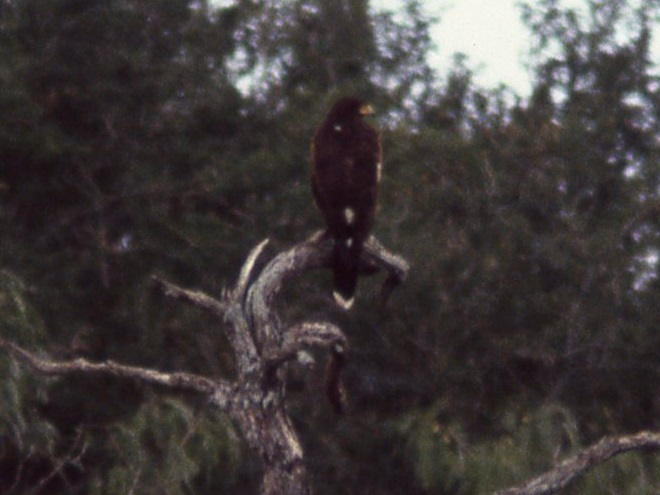
Also at Santa Ana N.W.R. a Giant Toad and a Texas Tortoise (Gopherus berlandieri), a scrubland native of south Texas and northern Mexico.
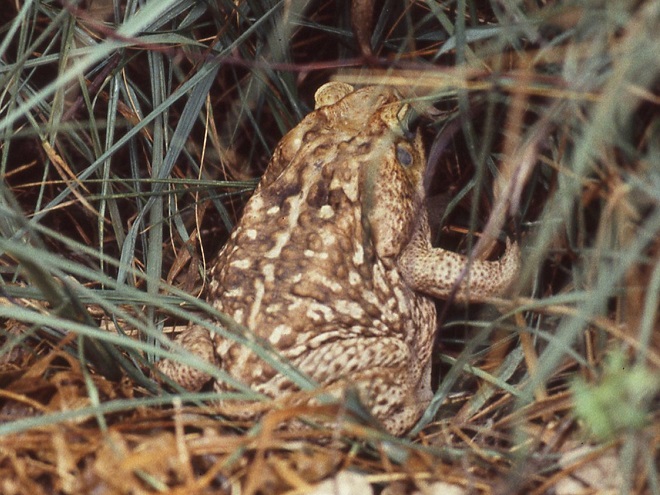
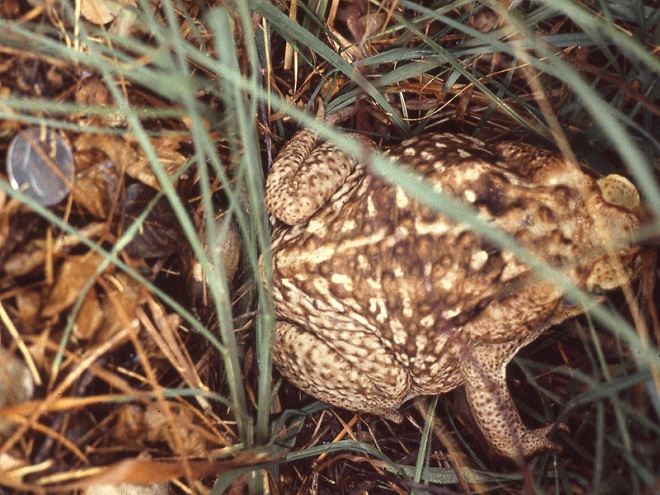
“We arrived back at Bentsen State Park and I got supper ready while the others birded. At dusk we saw the Elf Owls again and toured the roads. Saw two Pauraques. To bed by 11:15 after a welcome shower.”
A White-eyed Vireo was found during our late afternoon walk. On a tip from Father Tom, we checked the campground in the area of the east restrooms for nesting Tropical Parulas (Setophaga pitiayumi). For each of us, it was another of the five target species for the trip. We heard nothing that resembled this warbler’s song, which sounds very much like that of the Northern Parula with which we were each familiar.
Nightjars are more often seen than heard, so having the opportunity to finish the day watching two Common Pauraques sail across a break in the forest to grab airborne insects was a real treat.
Forty Years Ago in the Lower Rio Grande Valley: Day Five
Back in late May of 1983, four members of the Lancaster County Bird Club—Russ Markert, Harold Morrrin, Steve Santner, and your editor—embarked on an energetic trip to find, observe, and photograph birds in the Lower Rio Grande Valley of Texas. What follows is a daily account of that two-week-long expedition. Notes logged by Markert some four decades ago are quoted in italics. The images are scans of 35 mm color slide photographs taken along the way by your editor.
DAY FIVE—May 25, 1983
Bentsen State Park, Texas
Went to bed last nite about 11:30. Did not set the alarm. Very hot — Awoke at 7:30 A.M. We circled the campground and then drove to the river trail. We walked to the river, getting more lifers for Larry — Couch’s Kingbird, Olive Sparrow, and Groove-billed Ani. The Couch’s Kingbird is my first lifer of the trip. The Olive Sparrow has the same cadence as the Tennessee Warbler. We then checked the resaca and found a Least Bittern.
While checking out the cattails at the resaca, we failed to catch a glimpse of a Coues’ Rice Rat (Oryzomys couesi), a semi-aquatic mammal that lives only in the Rio Grande Valley and areas south into Central America. Instead we found an Eastern Fox Squirrel (Sciurus niger), a giant compared to the gray squirrels in Pennsylvania. Things really are bigger in Texas.
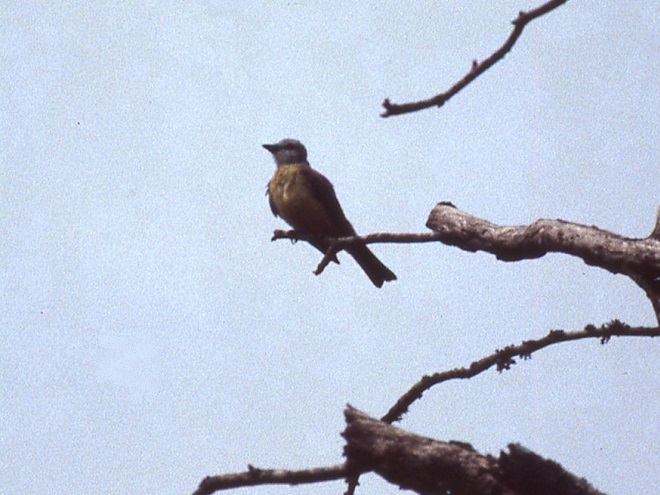
Back to our camp site for lunch, after paying for our stay at the office. P.M. — Put out corn and sunflower seeds and loafed all P.M. trying to get pictures. Larry had a lot of luck. I did not do so good.
Plain Chachalacas, White-winged Doves, White-tipped Doves, Great-tailed Grackles, and a Bronzed Cowbird stopped by to sample the seed offerings. The chachalacas and grackles created quite a racket. It’s a good thing we didn’t have any neighbors close by!
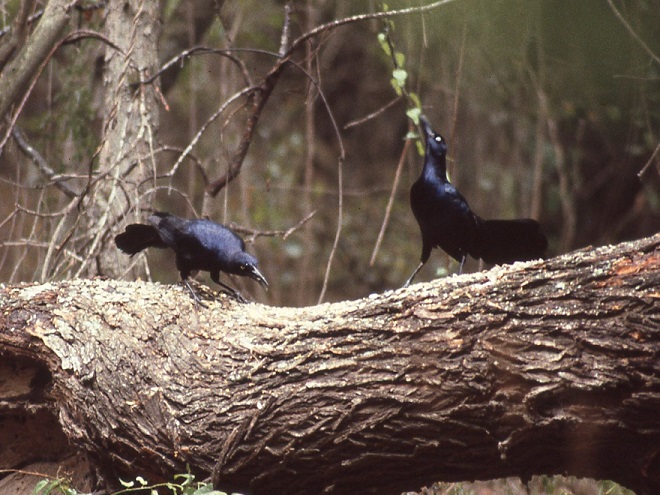
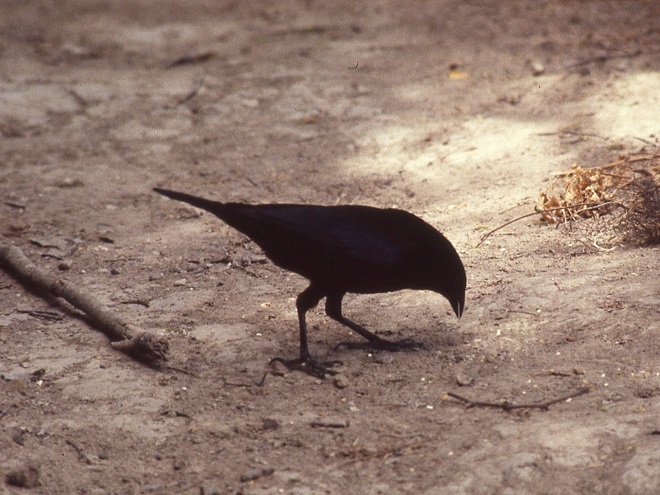
In nearby areas of the campground there were many species—Black-bellied Whistling Duck, Anhinga, Great Egret, Common Gallinule, Turkey Vulture, Yellow-billed Cuckoo, Golden-fronted Woodpecker, Ladder-backed Woodpecker, Eastern Kingbird, Brown-crested Flycatcher, Curve-billed Thrasher, Long-billed Thrasher (Toxostoma longirostre), Altamira Oriole, and Northern Cardinal.
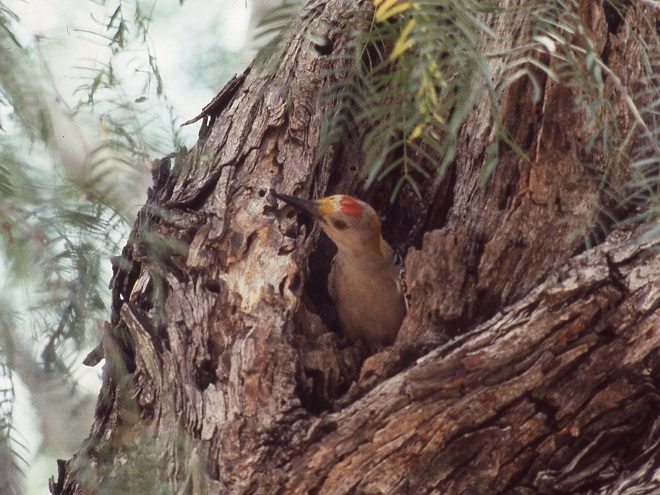
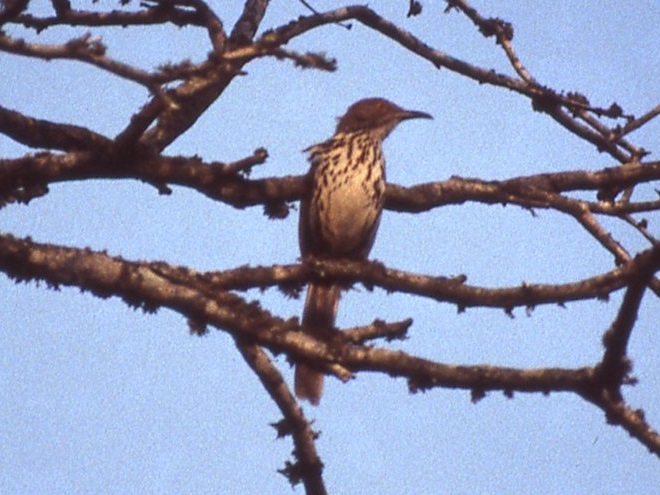
Rain is rare here — The rainy season produced no rain. Now a light rain is falling. The temperature dropped to 90° in the camper. One couple wanted to see anis. Larry picked one out 50 ft. from their campsite.
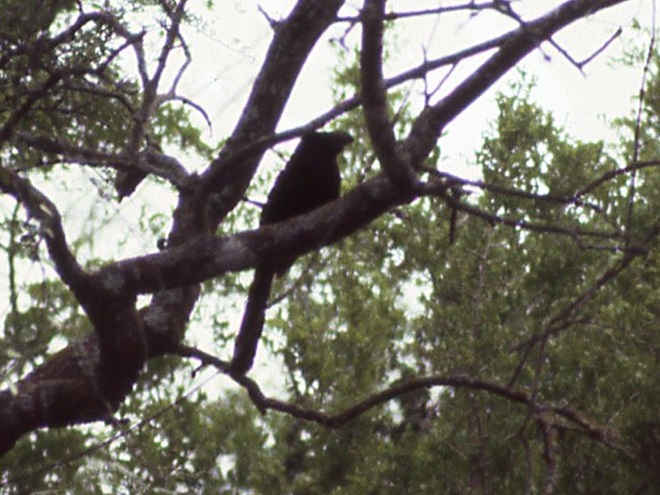
The rain cooled the air to make the evening tolerable, but we would pay for it tomorrow with an increase in the humidity.
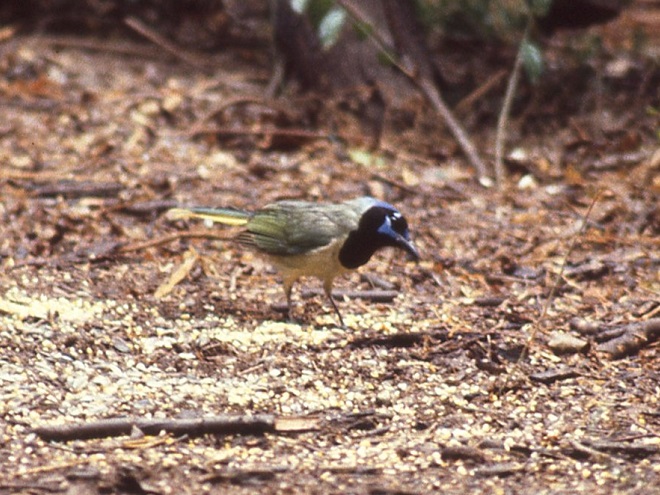
We paid for another nite and at dusk went to the Elf Owl tree where eventually 4 young came out and tried their wings and crawled around. The two adults flew in and Larry was ecstatic taking pictures with his strobe light. We met some people. One couple never saw Eastern Bluebirds. I gave him my card. Another couple pinpointed the owl tree.
This evening was certainly highlighted by the emergence of the young Elf Owls (Micrathene whitneyi) from their nest cavity. But in addition, we again heard the sounds of some of the other nocturnal birds found in the park—Common Nighthawk, Common Pauraque, and Eastern Screech Owl.
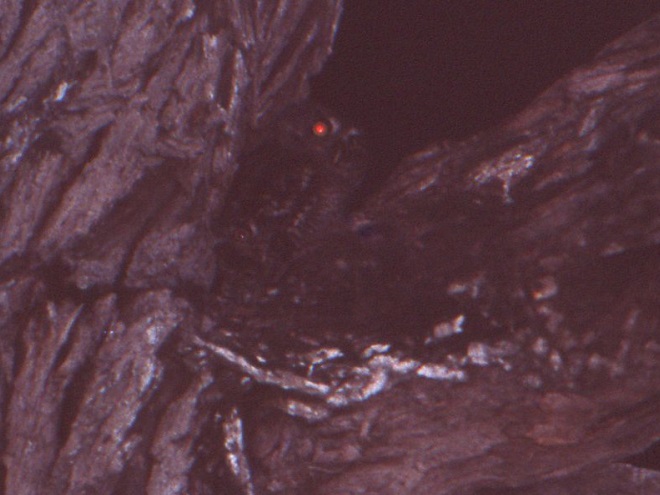
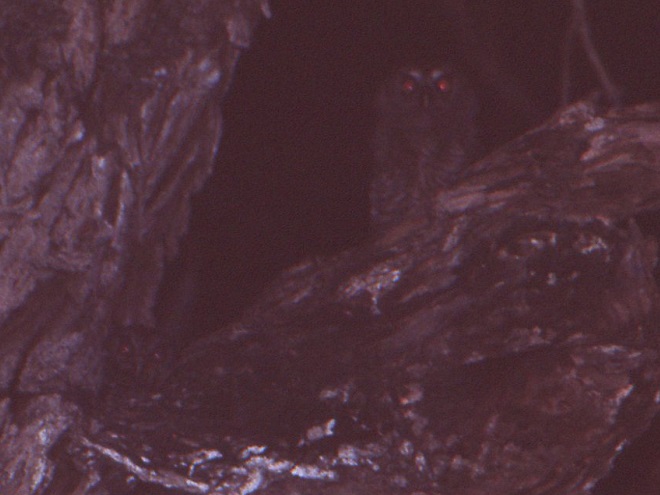
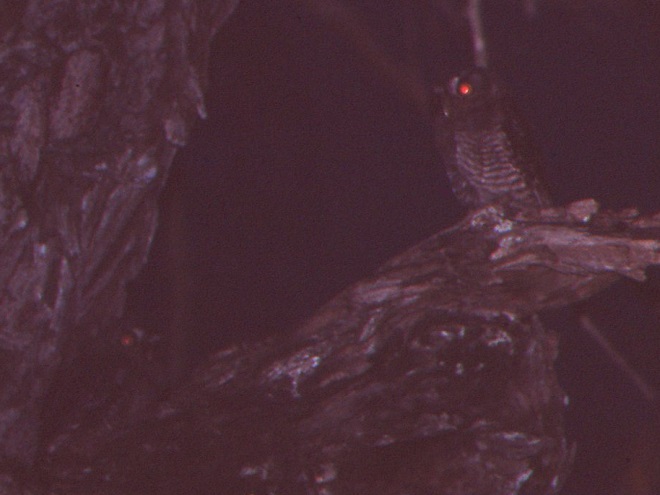
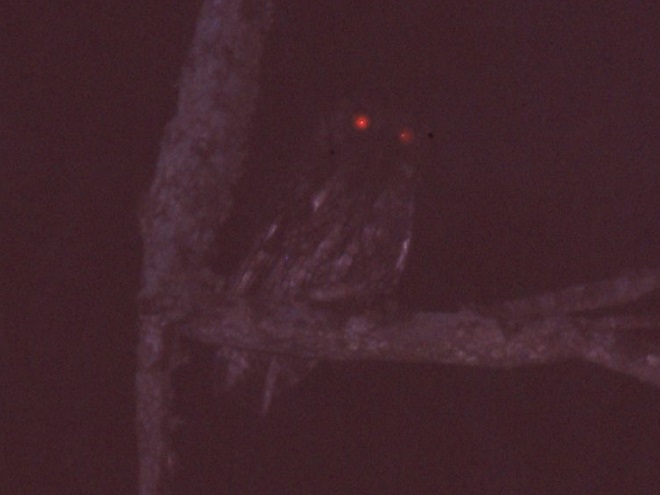
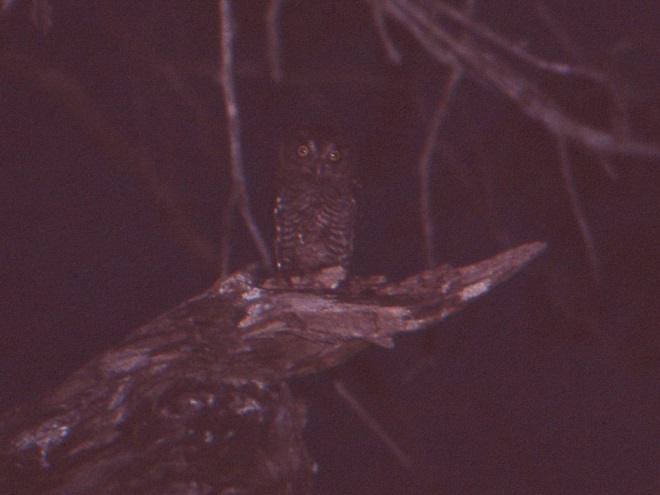
Forty Years Ago in the Lower Rio Grande Valley: Day Four
Back in late May of 1983, four members of the Lancaster County Bird Club—Russ Markert, Harold Morrrin, Steve Santner, and your editor—embarked on an energetic trip to find, observe, and photograph birds in the Lower Rio Grande Valley of Texas. What follows is a daily account of that two-week-long expedition. Notes logged by Markert some four decades ago are quoted in italics. The images are scans of 35 mm color slide photographs taken along the way by your editor.
DAY FOUR—May 24, 1983
“AOK Campground—South of Kingsville, Texas”
“Arose at 6:30 A.M. to the tune of Common Nighthawks. After breakfast, we headed for Harlingen. While driving south we saw six pairs of Black-bellied Whistling Ducks. At Harlingen we phoned Father Tom, who is an expert birder for the area.”
As we drove south to Harlingen, much our 100-mile route was through the Laureles division of the King Ranch, the largest ranch in the United States. It covers over 800,000 acres and is larger than the state of Rhode Island. The road there was as straight as an arrow with wire fences on both sides and scrubland as far as the eye could see. Things really are bigger in Texas.
Once in Harlingen, we did two things no one needs to do anymore:
-
-
- Find a coin-operated telephone to place a call to Father Tom.
- Ask Father Tom for the latest tips on the locations of rare and/or target birds.
-
Today, nearly everyone traveling such distances to find birds is carrying a cellular phone and many can use theirs to access internet sites and databases such as eBird to get current sighting information. Back in 1983, Father Tom Pincelli was a dear friend to birders visiting the Lower Rio Grande Valley. Few places had a person who was willing to answer the phone and field inquiries regarding the latest whereabouts of this or that bird. To remain current, he also had to religiously (forgive me for the pun) collect sighting information from the observers with whom he had contact. For locations elsewhere across the country, a birder in 1983 was happy just to have a phone number for a hotline with a tape-recorded message listing the unusual sightings for its covered region. If you were lucky, the volunteer logging the sightings would be able to update the tape once a week. For those who dialed his number, Father Tom provided an exceptionally personal experience.
Since 1983, Father Tom Pincelli, also known as “Father Bird”, has tirelessly promoted birding and conservation throughout the Lower Rio Grande Valley. His efforts have included hosting a P.B.S. television program and writing columns for local newspapers. He has been instrumental in developing the annual Rio Grande Valley Birding Festival. The public sentiment he has generated for the birding paradise that is the Lower Rio Grande Valley has helped facilitate the acquisition and/or protection of many key parcels of land in the region.
“After receiving information on locations of Tropical Parula, Ferruginous Pygmy Owl, Hook-billed Kite, Brown Jay, and Clay-colored Robin, we went on to check out the Brownsville Airport where we will meet Harold and Steve Thursday noon.”
If we were going to see these five species in the American Birding Association listing area, then we would have to see them in the Lower Rio Grande Valley. All five were target birds for each of us, including Harold who had few other possibilities for new species on the trip. Father Tom provided us with tips for finding each.
I noticed as we began moving around Harlingen and Brownsville that Russ was swiftly getting his bearings—he had been here before and was starting to remember where things were. His ability to navigate his way around allowed us to keep moving and see a lot in a short time.
In Harlingen, we easily found Mourning Doves and the non-native Rock Pigeons, species we see regularly in Pennsylvania. We became more enthusiastic about doves and pigeons soon after when we saw the first of the several other species native to south Texas, the fragile little Inca Dove (Columbina inca), also known as the Mexican Dove.
“Next, to the Brownsville Dump to see the White-necked Ravens — Then to Mrs. Benn’s in Brownsville for the Buff-bellied Hummingbird. Both lifers for Larry.”
For birders wanting to see a White-necked Raven in the Lower Rio Grande Valley, the Brownsville Dump was the place to go. With very little effort—excluding a trip of nearly 2,000 miles to get there—we found them. Today, birders still go to the Brownsville Dump to find White-necked Ravens, though the dump is now called the Brownsville Landfill and the bird is known as the Chihuahuan Raven (Corvus cryptoleucus).
Mrs. Benn’s home was in a verdant residential neighborhood in Brownsville. She welcomed birders to come and see the Buff-bellied Hummingbirds that visited her feeder filled with sugar water. I don’t recall whether or not she kept a guest book for visitors to sign, but if she did, it would have included hundreds—maybe thousands—of names of people from all over North America who came to her garden to get a look at a Buff-bellied Hummingbird. After arriving, we waited a short time and sure enough, we watched a Buff-bellied Hummingbird (Amazilia yucatanensis) sipping Mrs. Benn’s home-brewed nectar from her glass feeder. This emerald hummingbird is primarily a Mexican species with a breeding range that extends north into the Lower Rio Grande Valley of Texas. When not breeding, a few will wander north and east along the Gulf Coastal Plain as far as Florida.
Other finds at Mrs Benn’s included White-winged Dove (Zenaida asiatica), Ash-throated Flycatcher (Myiarchus cinerascens), Brown-crested Flycatcher (Myiarchus tyrannulus), and Black-crested Titmouse (Baeolophus atricristatus), a species also known as Mexican Titmouse.

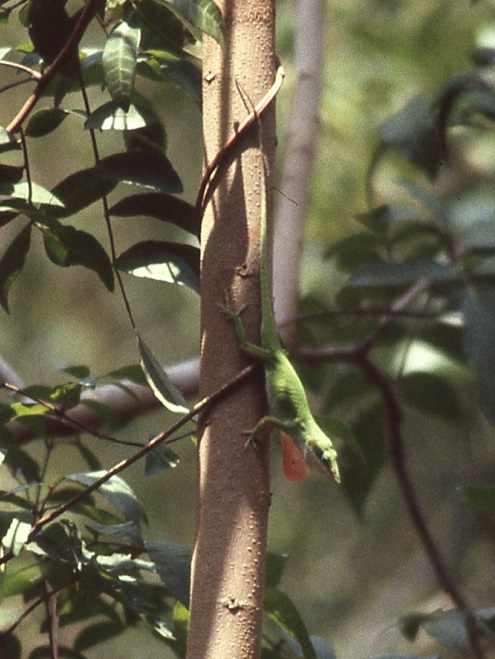
The Lower Rio Grande Valley from Rio Grande City east to the Gulf of Mexico is actually the river’s outflow delta. At least six historic channels have been delineated in Texas on the north side of the river’s present-day course. An equal number may exist south of the border in Mexico. Hundreds of oxbow lakes known as “resacas” mark the paths of the former channels through the delta. Many resacas are the centerpieces of parks, wildlife refuges, and housing developments. Still others are barely detectable after being buried in silt deposits left by the meandering river. Channelization, land disturbances related to agriculture, and a boom in urbanization throughout the valley have disconnected many of the most recently formed resacas from the river’s floodplain, preventing them from absorbing the impact of high-water events. These alterations to natural morphology can severely aggravate flooding and water pollution problems.
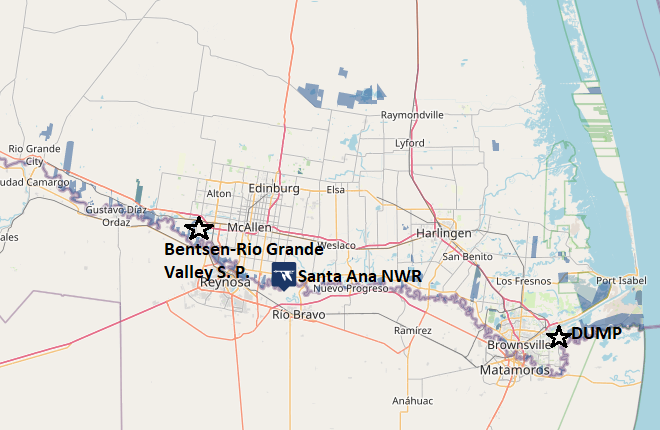
“On to Santa Ana National Wildlife Refuge. We walked to Pintail Lake and saw 6 Black-bellied Whistling Ducks and 2 Mississippi Kites and 1 Pied-billed Grebe. We drove the route thru the park with great results—Anhingas, Least Grebe, and more Black-bellied Whistling Ducks.
Santa Ana National Wildlife Refuge on the Rio Grande is not only a birder’s mecca, 300 species of butterflies have been identified there. That’s half the species known to occur in the United States! Its subtropical riparian forest and resaca lakes provide habitat for hundreds of migratory and resident bird species including many Central and South American species that reach the northern limit of their range in the Lower Rio Grande Valley. Two endangered cats occur in the park—the Ocelot (Leopardus pardalis) and the Jaguarundi (Herpailurus yagouaroundi).
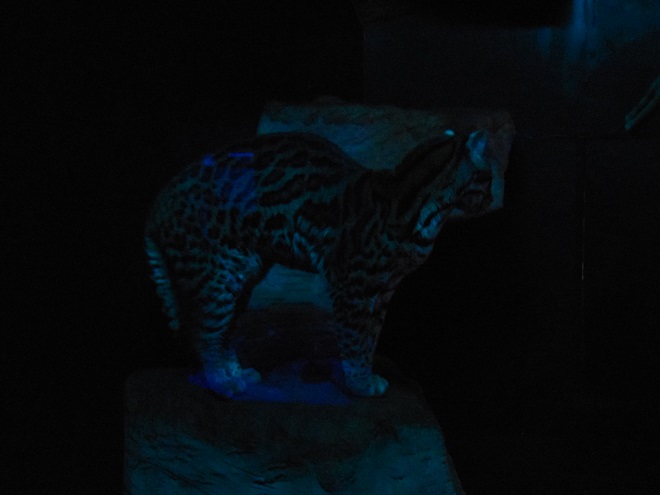
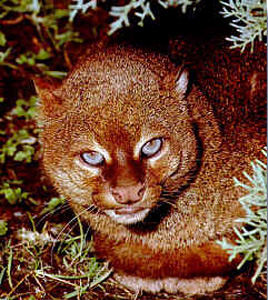
We saw no cats at Santa Ana, but did quite well with the birds. Our list included the species listed above plus Cattle Egret (Bubulcus ibis); Louisiana Heron, now known as Tricolored Heron (Egretta tricolor); Plain Chachalacas; Purple Gallinule; Common Gallinule (Gallinula galeata); American Coot; Killdeer; Greater Yellowlegs; the coastal Laughing Gull (Leucophaeus atricilla); and its close relative of the central flyway and continental interior, the Franklin’s Gull (Leucophaeus pipixcan). Others finds were White-winged Dove, Mourning Dove, Inca Dove, Yellow-billed Cuckoo, Golden-fronted Woodpecker, Ladder-backed Woodpecker (Dryobates scalaris), Brown-crested Flycatcher, Altamira Oriole, Great-tailed Grackle, and House Sparrow. A real standout was the colorful Green Jay (Cyanocorax luxosus), yet another tropical Central American species found north only as far as the Lower Rio Grande Valley.
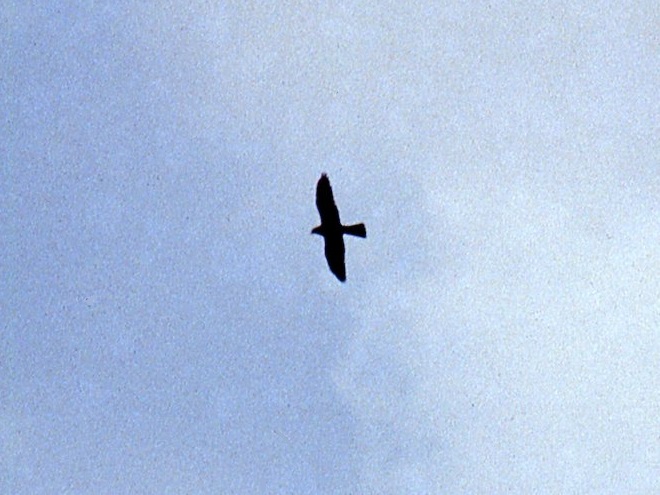
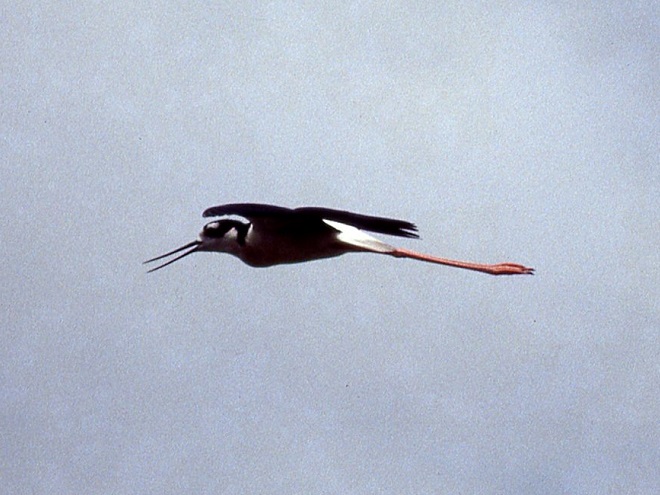

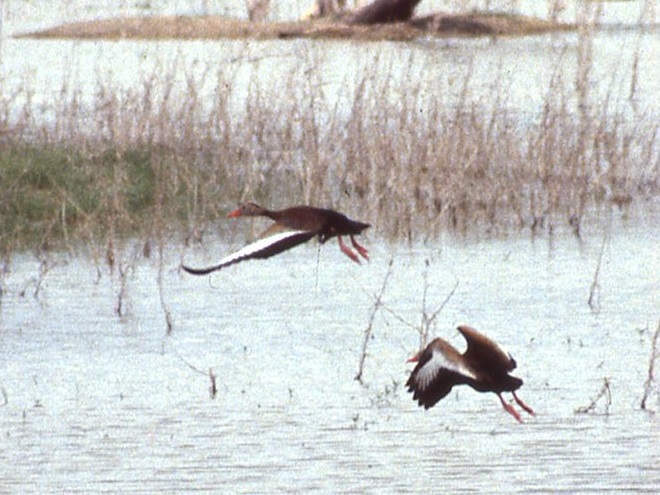
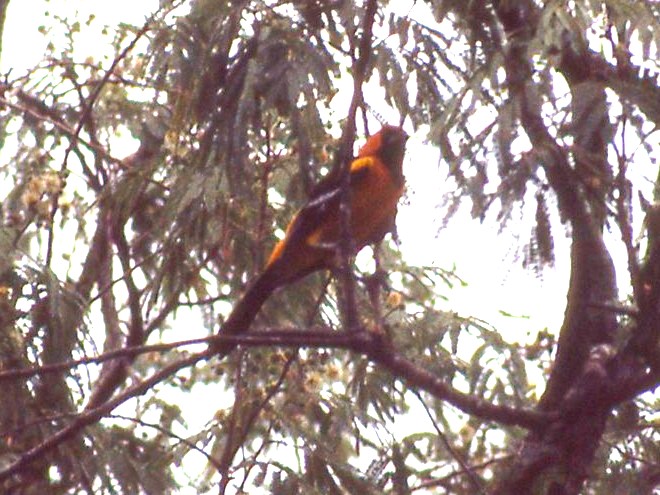
“We were unlucky not to find a campground at McAllen, so we went on to Bentsen State Park where we got a camp spot. After a sauerkraut supper, we birded till dark, then showered and wrote up the log. Very hot today.”
Bentsen-Rio Grande Valley State Park, like the Santa Ana National Wildlife Refuge, is located along the Rio Grande river and features dense subtropical riparian forest that grows in the naturally-deposited silt levees of the floodplain surrounding several lake-like oxbow resacas. Montezuma Bald Cypress (Taxodium mucronatum) is a native specialty found there but nowhere north of the Lower Rio Grande Valley. During our visit, we marveled at the epiphyte Spanish Moss (Tillandsia usneoides) adorning many of the more massive trees in the park. Willows lined much of the river shoreline.
Over time, flood control projects such as man-made dams, drainage ditches, and levees have impaired stormwater capture and aquifer recharge in the floodplain. These alterations to watershed hydrology have resulted in drier soils in many sections of the Lower Rio Grande Valley’s riparian forests. Where drier conditions persist, xeric (dry soil) scrubland plants are slowly overtaking the moisture-dependent species. As a result, the park’s woodlands are composed of trees with a variety of microclimatic requirements—Anaqua (Ehretia anacua), Cedar Elm (Ulmus crassifolia), Texas Ebony (Ebenopsis ebano), hackberry, mesquite, Mexican Ash (Fraxinus berlandieriana), retama, and tepeguaje are the principle species. The park’s subtropical Texas Wild Olive (Cordia boissieri) grows in the wild nowhere north of the Lower Rio Grande Valley.
While a majority of birders visiting Benten-Rio Grande State Park come to see the more tropical specialties of the riparian woods, searching the brushy habitat of the park’s scrubland can afford one the opportunity to see species typical of the southwestern United States and deserts of Mexico. This scrubland of the Lower Rio Grande Valley is part of the Tamaulipan Mezquital ecoregion, an area of xeric (dry soil) shrublands and deserts that extends northwest from the delta through most of south Texas and into the bordering provinces of northeastern Mexico.
Our campsite was located in prime birding habitat. We were a short walk away from one of the park’s flooded oxbow resacas and vegetation was thick along the roadsides. It was no surprise that the place abounded with birds. An evening stroll yielded Plain Chachalaca, White-winged Dove, Mourning Dove, White-fronted Dove, Golden-fronted Woodpecker, Brown-crested Flycatcher, Green Jay, Altamira Oriole, Great-tailed Grackle, and Bronzed Cowbird (Molothrus aeneus). At nightfall, we listened to the calls of an Eastern Screech Owl (Megascops asio), Common Nighthawks, and Common Pauraque (Nyctidromus albicollis), a nightjar of Central and South America that nests only as far north as the Lower Rio Grande Valley. The Common Pauraque is the tropical counterpart of the Eastern Whip-poor-will, a Neotropical migrant that nests in scattered forest locations throughout eastern North America.
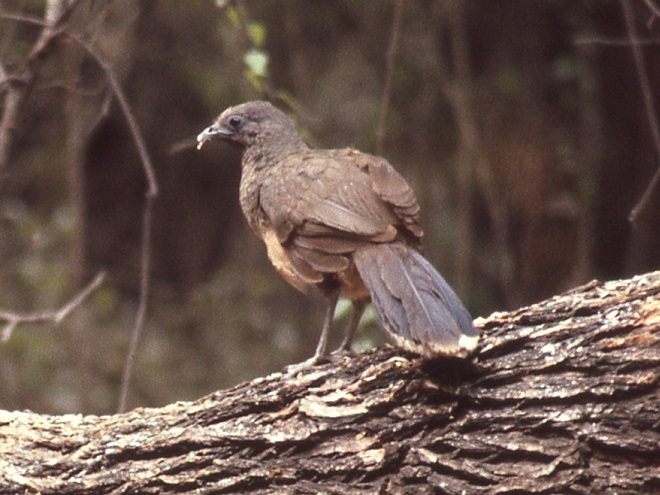
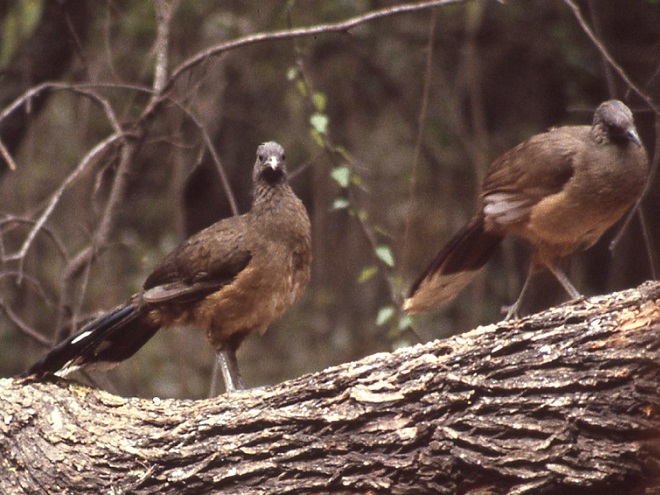
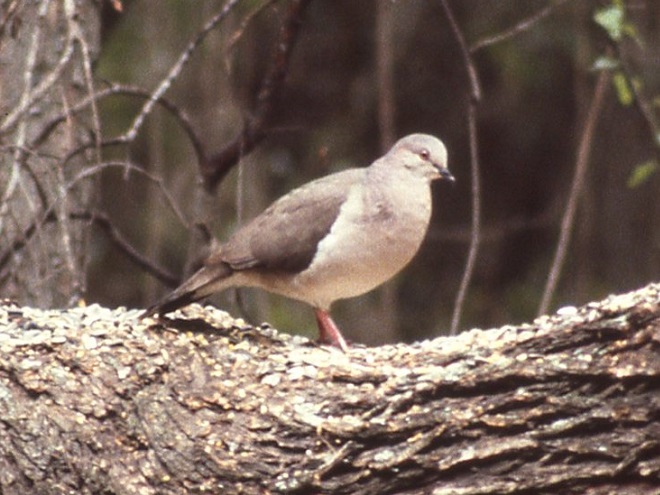
I would note that we saw no “snowbirds”—long-term vacationers from the northern states and Canada who fill the park through the cooler months of fall, winter, and spring. They were gone for the summer. But for a few other friendly folks, we had the entire campground to ourselves for the duration of our stay.
Forty Years Ago in the Lower Rio Grande Valley: Day Three
Back in late May of 1983, four members of the Lancaster County Bird Club—Russ Markert, Harold Morrrin, Steve Santner, and your editor—embarked on an energetic trip to find, observe, and photograph birds in the Lower Rio Grande Valley of Texas. What follows is a daily account of that two-week-long expedition. Notes logged by Markert some four decades ago are quoted in italics. The images are scans of 35 mm color slide photographs taken along the way by your editor.
DAY THREE—May 23, 1983
For Russ, Harold, and Steve, this trip would target several bird species each individual had never observed at any prior time in their lives. Upon seeing a new bird, they could add it to their personal “life list”. They, like thousands of other “listers”, were dedicated to the goal of having a life list that included over 600 species seen in the American Birding Association (A.B.A.) area—North America north of Mexico. Harold had traveled throughout much of North America (and the world) and had an A.B.A. life list well in excess of 600 species, thus he had seen nearly all of the regularly occurring birds in the coverage area. His chance for seeing new species was limited to vagrants that might wander into North America or tropical birds that, over time, had extended their range north of Mexico into the United States. I don’t recall how many species Russ and Steve had seen, but I know each had very few opportunities for new finds east of the Rocky Mountains. For all three of these men, the Lower Rio Grande Valley presented a best bet to add multiple species to their lists. I had never been south of Cape Hatteras or west of Pennsylvania, so I had the opportunity to add dozens of species to a life list. Throughout the trip, Russ, Harold, and Steve enthusiastically helped me locate and see new species. As a result, I saw over 50 new birds to add to my list.
One of the functions of the American Birding Association was to decide which bird species an observer could add to the life list. The official A.B.A. list was revised regularly to include not only regularly occurring native species, but vagrants as well. One of the trickier determinations was the status of introduced species. Back in 1983, a birder could count a Ring-necked Pheasant seen in Pennsylvania on their A.B.A. life list because they were thought to be freely reproducing with a population sustainably established in the state. Today, they are considered an exotic release and are not countable under A.B.A. rules.
Enter the Black Francolin (Francolinus francolinus), a member of the pheasant family that back in 1983, was countable under A.B.A. rules. Native to India, the Black Francolin was introduced into southwest Louisiana in 1961 and was apparently reproducing and established. Russ had a tip that they were seen with some regularity in areas of farmland, marsh, and oil fields south of Vinton, Louisiana. It was one of this trip’s target species for his life list.
“Ready for Black Francolin. Up at 5:30 — After breakfast, we went to Gum Cove Road. No Francolins, but at the end of the blacktop road, we had 5 Purple Gallinules in the scope at one time. King Rails were plentiful. We found a dead male Painted Bunting. Later, we saw a very beautiful live one. Water everywhere. Flooded fields everywhere. The road was flooded for about 50 yards at one point. White Ibis were abundant.”
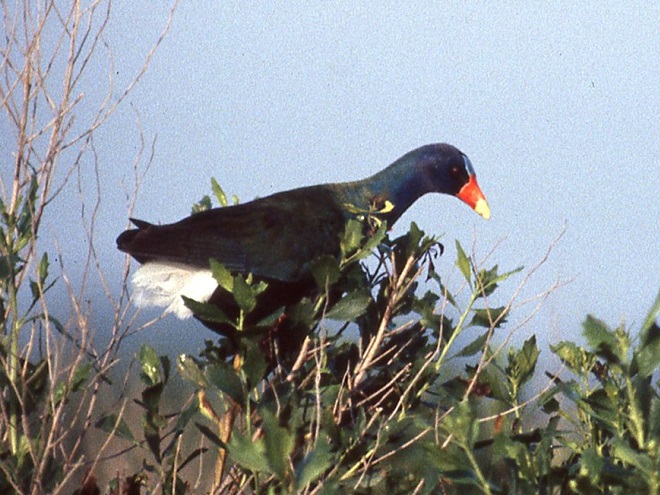
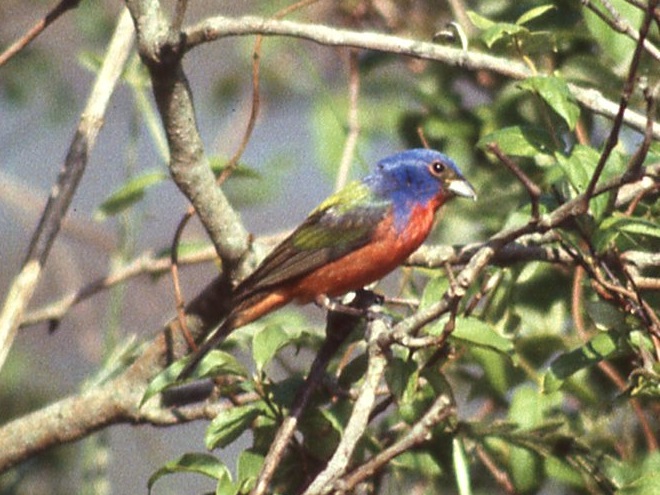
Other sightings of note along Gum Cove Road included: Northern Bobwhite, Common Nighthawk, Cattle Egret, Green Heron, American Bittern, Snowy Egret, Glossy Ibis, Black-necked Stilt (Himantopus mexicanus), Forster’s Tern, Black Tern, Yellow-billed Cuckoo, Eastern Kingbird, Purple Martin, Barn Swallow, Brown Thrasher, Loggerhead Shrike, Red-winged Blackbird, Brown-headed Cowbird, Eastern Meadowlark, Boat-tailed Grackle (Quiscalus major), and Great-tailed Grackle (Quiscalus mexicanus)—a very large and noisy blackbird I had never seen before.
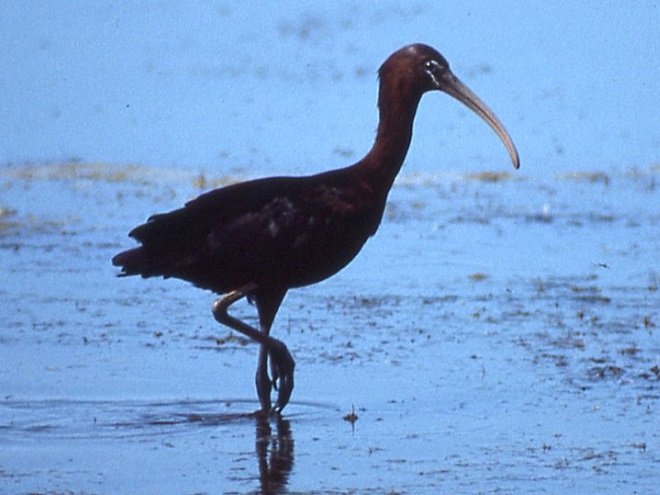
The reader may be interested to know that today, the area between Vinton and the Gulf of Mexico has largely been surrendered to the forces of the hurricanes that strike the region with some regularity. Cameron Parish* is a sparsely populated buffer zone of marshes, abundant wildlife, and oil and gas wells. Its population of more than 9,000 in 1983 has plunged to less than 6,000 today. Hurricane Rita (2005) and Hurricane Ike (2008) precipitated the sharp decline. The latter hurricane had a 22-foot storm surge that flooded areas 60 miles inland of the coastline. Following these storms, the majority of severely damaged and destroyed homes were not rebuilt and residents in the most affected areas relocated. In 2020, Hurricane Laura made landfall at Cameron Parish with record-tying 150 mph winds and a storm surge that pushed flood waters inland to Lake Charles. Six weeks later, Hurricane Delta followed with 100 mph winds. For government agencies, the emergency response required by these two storms was minimized by the reduced presence of people and/or their personal property.
* A parish in Louisiana is similar to a county in other states.
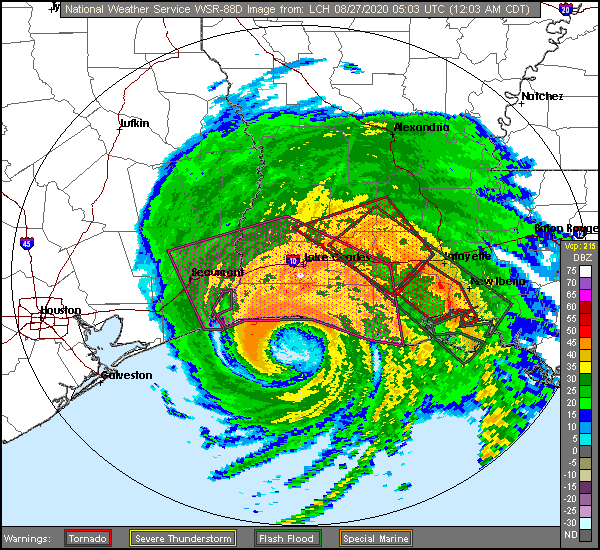
“After a quick stop at the camp grounds, where I slipped and fell in the shower last nite, we headed south. Larry saw many birds en route.”
Russ took a bad fall on a slippery wet concrete floor and had bruises to show for it. It worried me; he was 71 years old at the time. But he was adamant about continuing on and did so with great vigor.
Just hours after a sojourn through the swampy parcels south of Vinton, we were cruising through the metropolis of Houston, Texas, then across a landscape with less cultivated cropland and more scrubland with grazing. Here and there, but primarily to the east of Houston, blankets of roadside wildflowers painted the landscape with eye-popping color. Lady Bird Johnson encouraged the plantings soon after she and Lyndon returned to Texas upon leaving life in the White House in 1969. The sight of those vivid blooms was so memorable and so beautiful. One couldn’t resist making nasty comparisons to the gobs of mowed grass and mangled trash along the highways back in Pennsylvania.
Birds along the way: Ruby-throated Hummingbird, Common Nighthawk, Black-bellied Whistling Duck, Yellow-crowned Night Heron, Great Blue, Heron, Great Egret, Black Vulture, Turkey Vulture, Red-tailed Hawk, Laughing Gull, Black Tern, Scissor-tailed Flycatcher, Cliff Swallow, Loggerhead Shrike, and Painted Bunting. I saw my first Black-bellied Whistling Ducks (Dendrocygna autumnalis) and Golden-fronted Woodpecker (Melanerpes aurifrons) near Woodsboro, Texas, and added both to my life list.
“We stopped for the nite at an A OK camp ground 7 miles south of Kingsville.”
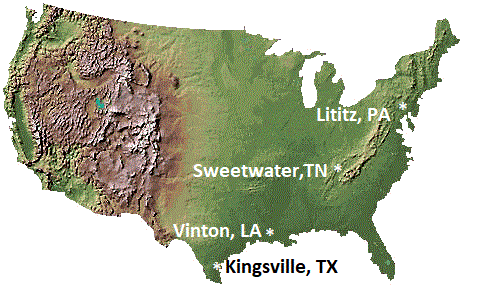
Birds at the camp included two Black-bellied Whistling Ducks flying overhead, Common Nighthawk, Golden-fronted Woodpecker, Blue Grosbeak, and another “lifer”—Curve-billed Thrasher (Toxostoma curvirostre).
We also saw a Mexican Ground Squirrel (Ictidomys mexicanus), easily identified by the rows of white spots running the length of its back.
While relaxing at the campsite that evening, we watched the landscape darken and remarked how interesting it was that the glowing red sun had yet to set below the distant horizon—a land so very flat and air so hazy and humid.
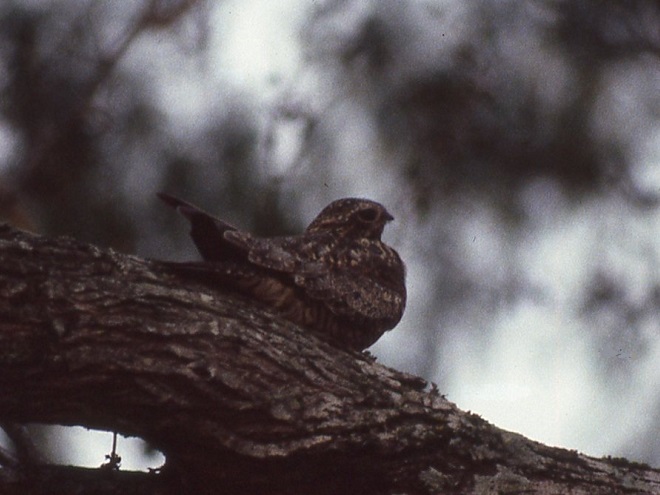
Forty Years Ago in the Lower Rio Grande Valley: Day Two
Back in late May of 1983, four members of the Lancaster County Bird Club—Russ Markert, Harold Morrrin, Steve Santner, and your editor—embarked on an energetic trip to find, observe, and photograph birds in the Lower Rio Grande Valley of Texas. What follows is a daily account of that two-week-long expedition. Notes logged by Markert some four decades ago are quoted in italics. The images are scans of 35 mm color slide photographs taken along the way by your editor.
DAY TWO—May 22, 1983
Our goal today was to continue traveling and reach western Louisiana.
“We were on our way at 6:08. Stopped for a quick lunch in the camper and drove to Vinton, Louisiana, KOA. Lots of hard rain through Tennessee, Georgia, and Alabama.
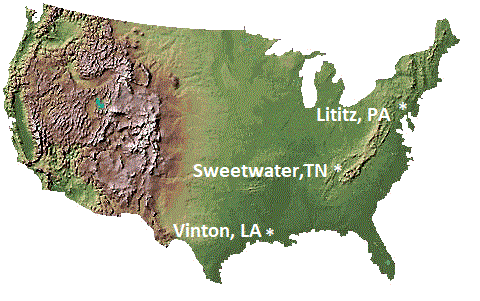
As we crossed Mississippi and entered Louisiana, we left the rain and the Appalachians behind. Upon crossing the Mississippi River, we had arrived in the West Gulf Coastal Plain, the physiographic province that extends all the way south along the Texas coast to Mexico and includes the Lower Rio Grande Valley. West of Baton Rouge, we began seeing waders in the picturesque Bald Cypress swamps—Great Egrets, Green Herons (Butorides virescens), Little Blue Herons (Egretta caerulea), and Glossy Ibis (Plegadis falcinellus) were identified. A Pileated Woodpecker was observed as it flew above the roadside treetops.
The rains we endured earlier in the trip had left there mark in much of Louisiana and Texas. Flooding in agricultural fields was widespread and the flat landscape often appeared inundated as far as the eye could see. Along the highway near Vinton, we spotted the first two of the many southern specialties we would find on the trip, a Loggerhead Shrike (Lanius ludovicianus) and a Scissor-tailed Flycatcher (Tyrannus forficatus), both perched on utility wires and searching for a meal.
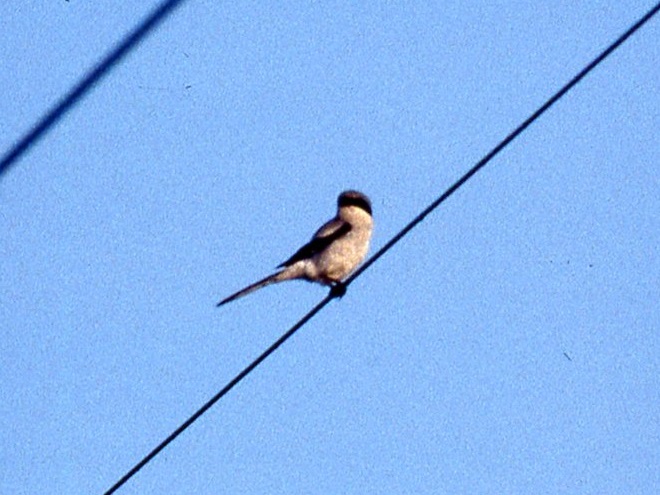
Forty Years Ago in the Lower Rio Grande Valley: Day One
Back in late May of 1983, four members of the Lancaster County Bird Club—Russ Markert, Harold Morrrin, Steve Santner, and your editor—embarked on an energetic trip to find, observe, and photograph birds in the Lower Rio Grande Valley of Texas. What follows is a daily account of that two-week-long expedition. Notes logged by Markert some four decades ago are quoted in italics. The images are scans of 35 mm color slide photographs taken along the way by your editor.
The trip was scheduled to coincide with breeding season in order to provide a good chance of locating a number of tropical species that happen to reach the northern limit of their range along the Lower Rio Grande. In addition, there was the possibility of seeing many northbound end-of-season spring migrants funneling through the valley as they followed the Gulf Coast on their way to nesting grounds in eastern and central sections of the United States and Canada.
DAY ONE—May 21, 1983
The trip began at Russ Markert’s home in Lititz, Pennsylvania where I slept the night before departure. Markert’s van camper would be both our mode of transportation and accommodation for the journey. Upon arrival in south Texas, we would pick up Harold Morrin and Steve Santner at the Brownsville Airport. They would join us for a week before returning by air to Pennsylvania.
“Larry slept at my house last night so we could get an early start today — camper packed and read to go. Arose at 5:30. We alternated driving, about every two hours. Heavy rain through Virginia and West Virginia. Arrived at Sweetwater KOA, Tennessee, at 5:30 P.M. The weather turned to rain.”

Northern Bobwhite were among the many birds of farm and field at the Sweetwater KOA campground. After dinner and before the rain began, I recall going for a swim in the pool, something I craved being able to do during the sweltering evenings we would experience in south Texas during the week to follow.
We’re Going Back in Time, Back to the Border
Mother’s Day Flowers
Let’s have a look at some of the magnificent native wildflowers blooming on this Mother’s Day in forests and thickets throughout the Lower Susquehanna River Watershed.

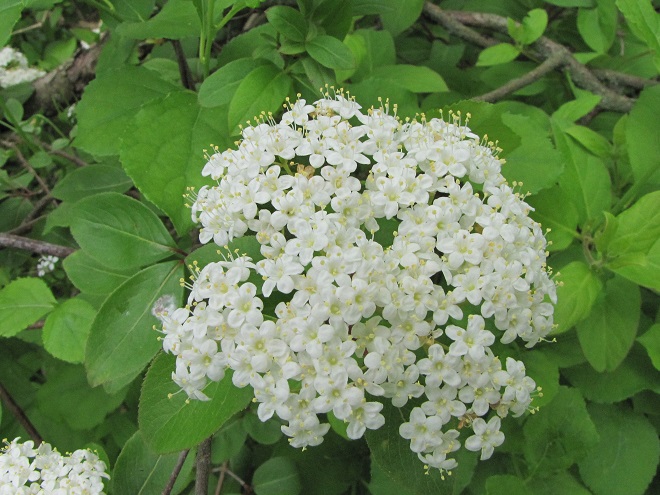

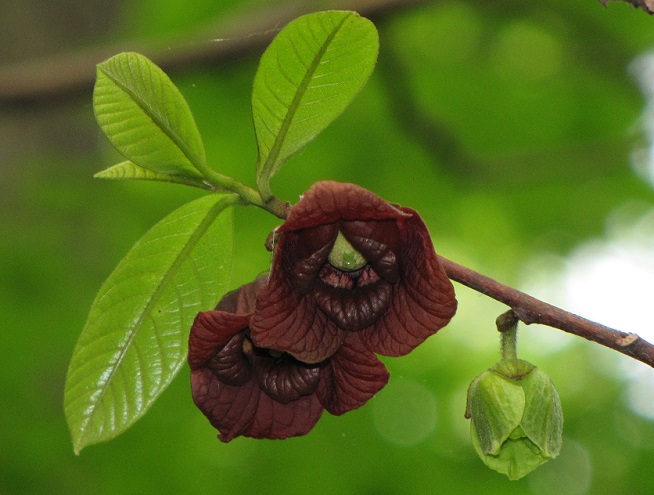
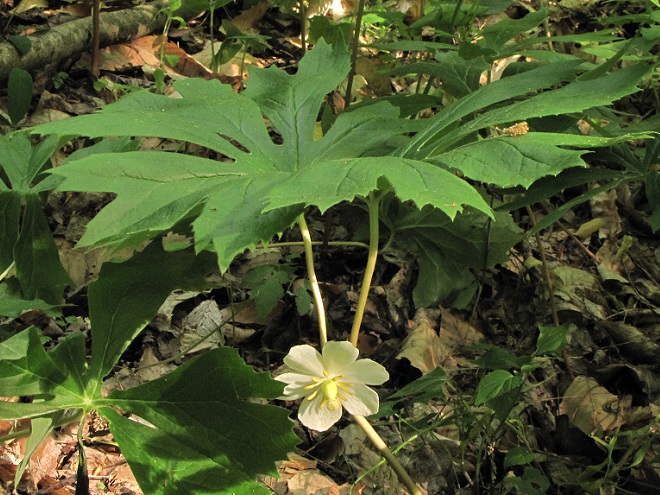
Aren’t they spectacular?
Why not take a stroll to have a look at these and other plants you can find growing along a nearby woodland trail? You could check out some place new and get a little exercise too!
If you go, please tread lightly, take your camera, mind your manners, and…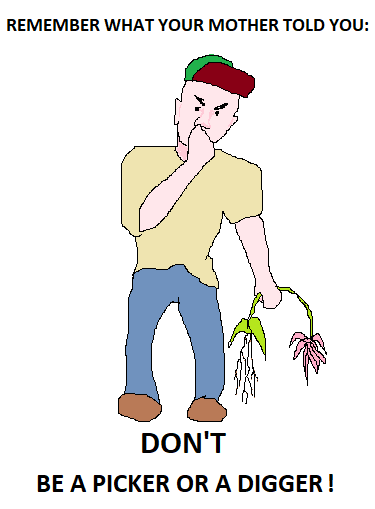
Photo of the Day
Photo of the Day
What’s Flying Right Now
Here’s a quick look at just a few of the birds that have been moving northward in recent days…
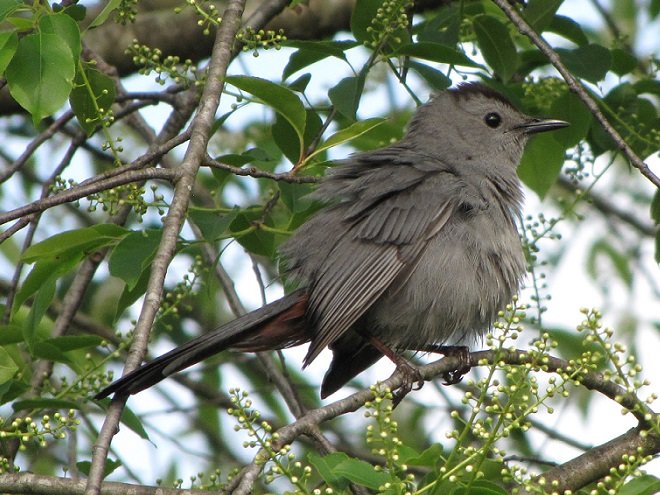
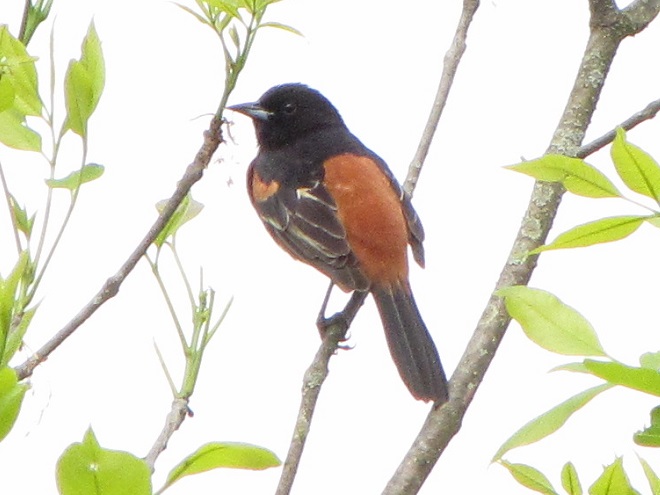

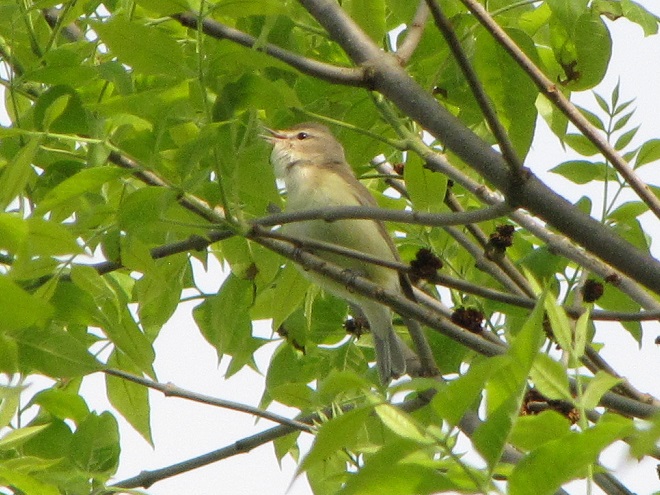

Stalled Migration About to Resume
For nearly a week now, a slow-moving low pressure system has not only brought heavy rain and cold temperatures to the northeastern United States, it has also stalled the northbound flights of migrating Neotropical birds. As this weather system at last drifts offshore, birds including warblers, thrushes, vireos, flycatchers, catbirds, hummingbirds, orioles, tanagers, and others should again resume their northward movements.
National Weather Service radar presently displays returns of these airborne nocturnal migrants in clear storm-free skies throughout the eastern half of the United States and Canada. As the showers and clouds depart the lower Susquehanna valley and areas to the north, the birds immediately to our south will begin to fill the void.
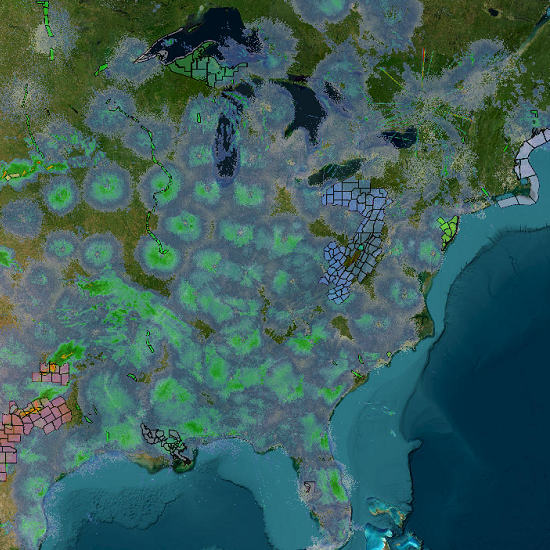
Our advice to you…plan to spend some time outdoors this weekend looking for our colorful Neotropical visitors. Their springtime songs should fill the warm air of forest and thicket. You won’t want to miss it.
How Much Rainwater Runs Off Your Roof During a Storm?
During the spare time you have on a rainy day like today, you may have asked yourself, “Just how much water do people collect with those rain barrels they have attached to their downspouts?” That’s a good question. Let’s do a little math to figure it out.
First, we need to determine the area of the roof in square feet. There’s no need to climb up there and measure angles, etc. After all, we’re not ordering shingles—we’re trying to figure out the surface area upon which rain will fall vertically and be collected. For our estimate, knowing the footprint of the building under roof will suffice. We’ll use a very common footprint as an example—1,200 square feet.
40′ x 30′ = 1,200 sq. ft.
By dividing the area of the roof by 12, we can calculate the volume of water in cubic feet that is drained by the spouting for each inch of rainfall…
1,200 ÷ 12 = 100 cu. ft. per inch of rainfall
Next, we multiply the volume of water in cubic feet by 7.48 to convert it to gallons per inch of rainfall…
100 x 7.48 = 748 gallons per inch of rainfall
That’s a lot of water. Just one inch of rain could easily fill more than a single rain barrel on a downspout. Many homemade rain barrels are fabricated using recycled 55-gallon drums. Commercially manufactured ones are usually smaller. Therefore, we can safely say that in the case of a building with a footprint of 1,200 square feet, an array of at least 14 rain barrels is required to collect and save just one inch of rainfall. Wow!
Why send that roof water down the street, down the drain, down the creek, or into the neighbors property? Wouldn’t it be better to catch it for use around the garden? At the very least, shouldn’t we be infiltrating all the water we can into the ground to recharge the aquifer? Why contribute to flooding when you and I are gonna need that water some day? Remember, the ocean doesn’t need the excess runoff—it’s already full.
Photo of the Day
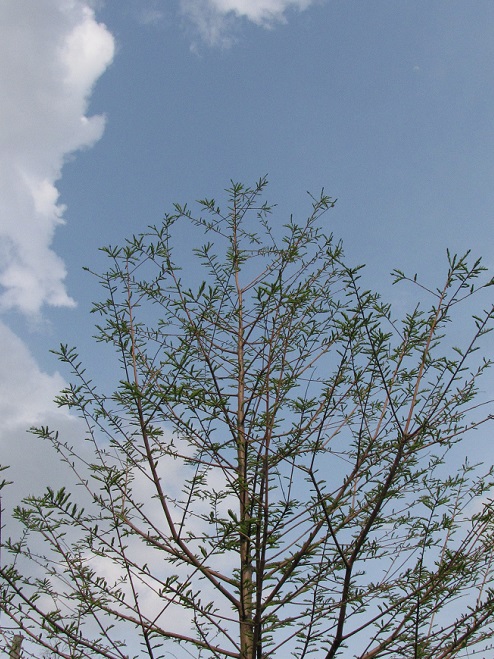
Photo of the Day
Photo of the Day: It’s the Daily Double
Photo of the Day
Thank You Volunteers!
As your editor here at susquehannawildlife.net, I’d like to take a moment to thank all the volunteers who gave of their valuable time today to pick up litter, plant trees, and take other civic actions in observance of Earth Day. Your hard work has not gone unnoticed.
Special appreciation goes out to the anonymous crew that worked its way through the area surrounding our headquarters to pick up the trash on the rental and business properties in the neighborhood. My personal thanks is extended to you.
If you’ve never lived in an urban or downtown area, you’re probably unaware of the environmental damage and decline in the quality of life that occurs when “investors” start buying up the houses near you. The first things to go are the trees and shrubs—less maintenance that way. Next, more paving is installed to park more cars. That leads to more stormwater runoff, so look out if you happen to live downstream. Then the long-term neglect begins. The absentee “slumlords” show up only to collect the rent, if at all. Unless the tenants are conscientious enough to do a little sweeping, the rubbish begins to accumulate. It’s a funny thing, when there’s a bunch of junk lying around, people feel compelled to start dumping more. So to you volunteers who today helped nip the problem in the bud with your efforts, I want you to know that you’re the best! As for you greedy landlords—shame on you.
Termite Terminators
With temperatures on the rise in this morning’s bright sunshine, a flight of Eastern Subterranean Termites (Reticulitermes flavipes) streamed from the shelter of this tree snag to ascend skyward in a spreading cloud of kings and queens looking to start new colonies of wood chompers.
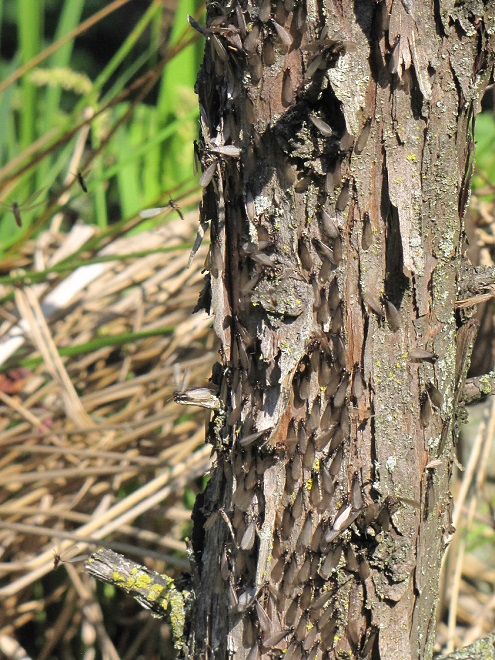
As the swarm cleared the treetops, it immediately attracted the attention of some recently-arrived migratory birds…
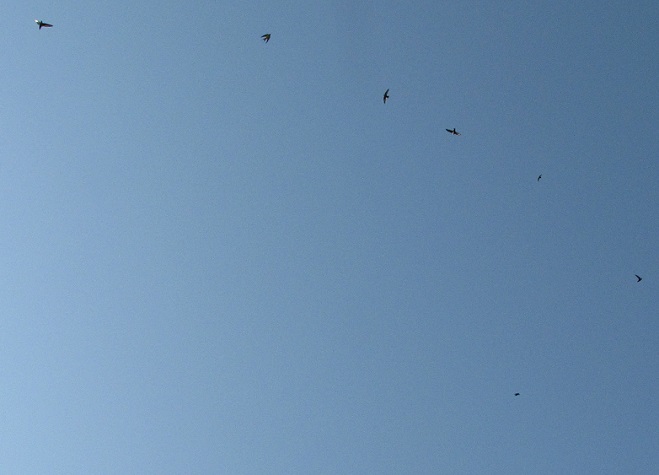
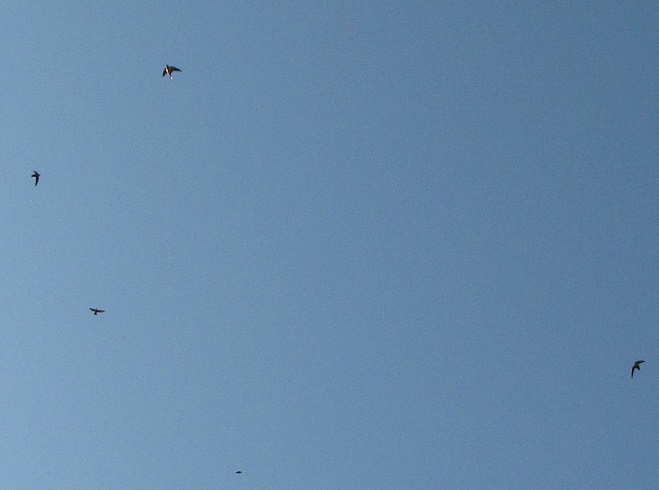
Photo of the Day
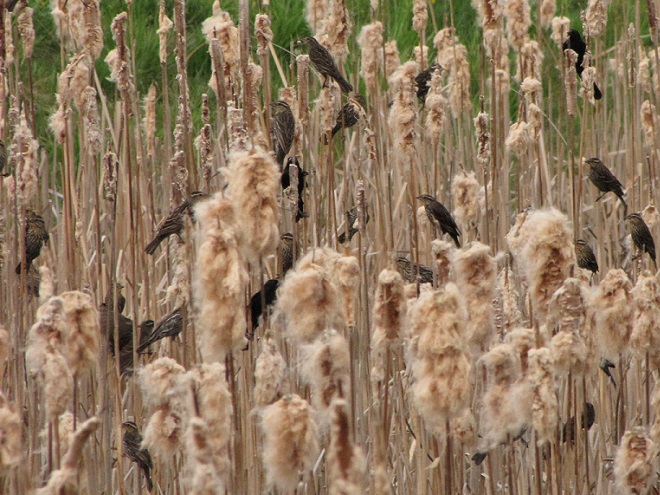
Photo of the Day
Photo of the Day
Photo of the Day
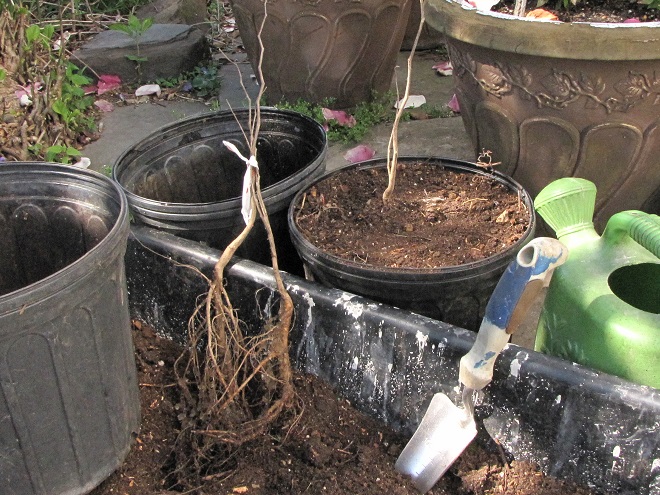
Photo of the Day
